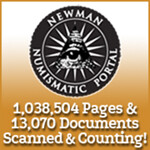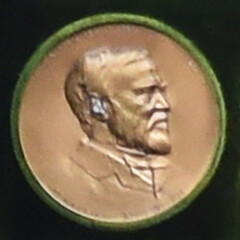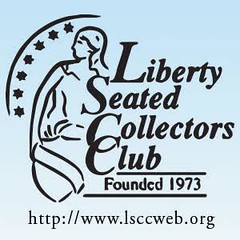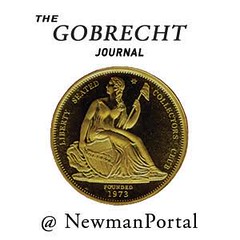
About UsThe Numismatic Bibliomania Society is a non-profit organization devoted to the study and enjoyment of numismatic literature. For more information please see our web site at coinbooks.org SubscriptionsThose wishing to become new E-Sylum subscribers (or wishing to Unsubscribe) can go to the following web page link MembershipThere is a membership application available on the web site Membership Application To join, print the application and return it with your check to the address printed on the application. Print/Digital membership is $40 to addresses in the U.S., and $60 elsewhere. A digital-only membership is available for $25. For those without web access, write to: Terry White, Treasurer
AsylumFor Asylum mailing address changes and other membership questions, contact Terry at this email address: terrywhite5475@yahoo.com SubmissionsTo submit items for publication in The E-Sylum, just Reply to this message, or write to the Editor at this address: whomren@gmail.com BUY THE BOOK BEFORE THE COINSale Calendar
|
- WAYNE'S WORDS: THE E-SYLUM MAY 7, 2017
- NEW BOOK: 2018 U.S COIN DIGEST, 16TH EDITION
- NEW BOOKS: THIRD REICH MEDALS AND HONORS
- REVISED BOOK: THE BANKOTE BOOK
- RED BOOK RECOLLECTIONS: DAVID LANGE
- IMAGE-BASED ROMAN COIN IDENTIFICATION
- TEICHMAN INDEXES VIRGIL BRAND LEDGERS AT ANS
- NOTES FROM E-SYLUM READERS: MAY 7, 2017
- U.S. MINT INTERVIEW ON APOLLO 11 DESIGNS
- BRENNER'S 1895 ONE DOLLAR COIN DESIGN
- VOCABULARY TERM: DIAPER
- WILLIAM PENN BROWN (1841-1929)
- CONRAD MOWER NIELSEN (1922-2008)
- THE BRITISH MUSEUM MONEY MATTERS EXHIBITION
- SELECTIONS FROM NUMISMATICA ARS CLASSICA #99-100
- ERIC P. NEWMAN INTERNET 3 SALE RESULTS
- LEGEND REGENCY AUCTION XXI HIGHLIGHTS
- LORD ST. OSWALD 1794 DOLLAR OFFERED
- STACK'S BOWERS MAY 2017 WORLD ONLINE AUCTION
- NUMISMATIC NUGGETS: MAY 7, 2017
- AZERBAIJAN MEDIEVAL BRONZE COIN HOARD FOUND
- MORE ON THE G. ERICHSON COUNTERSTAMP
- MORE ON GUY FAWKES AND THE GUNPOWDER PLOT
- AMERICA'S WWI ENTRANCE MEDALS
- CHAMPION PAPER COMPANY MEDALS
- OHIO TRUMP INAUGURAL MEDAL OFFERED IN SILVER
- AUSTRIA UNVEILS MIKROKOSMOS SILVER NIOBIUM COIN
- QUIDS ON THE SKIDS: ERROR POUND COINS APPEAR
- NOTES ON EMPEROR NORTON'S PRINTERS
- INTERVIEW WITH CRANE CURRENCY CEO DEFALCO
- COLLECTOR DISPLAYS BERMUDA BANKNOTES
- INDIA BANKNOTE BAN VICTIM SEEKS HELP
- DIGITIZING ONE OF THE WORLD’S LARGEST BOOKS
- COIN ART BY STACEY LEE WEBBER
- FEATURED WEB PAGE: THE WATERLOO MEDAL DIES
Click here to access the complete archive
To comment or submit articles, reply to whomren@gmail.com
Content presented in The E-Sylum is not necessarily researched or independently fact-checked, and views expressed do not necessarily represent those of the Numismatic Bibliomania Society.
WAYNE'S WORDS: THE E-SYLUM MAY 7, 2017
 New subscribers this week include: Jan Valentine, courtesy of Jim Neiswinte; Keemboh Alcaraz, Joao Almeida, Aritz Arantzegi Areitio, Minor W Anderson, Bill Bone, Steven Bron, Andrew Briton,
Ron Caris, Andres Collazosm, Kamil Coskun, Ken Denham, Gunter Gerstner, Mario Grana, Jerry Hook, Matija Horvat, Mohamed Ibrahim, Miskell John, Bharat Kadge, Cheang Wai Keong, Werner Kober, Joseph
Kutta, Yale Lansky, Mark Lee, Calum McLean, Anton Menshikov, Carlos Mariano, Frederic Minguet, Rafal Nogowczyk, Alexey Novikov, Calogero Saieva, Monique Salmon, Alexey Semakov, Simon Sui, Adam Work,
and Hyunchul Yoo.
New subscribers this week include: Jan Valentine, courtesy of Jim Neiswinte; Keemboh Alcaraz, Joao Almeida, Aritz Arantzegi Areitio, Minor W Anderson, Bill Bone, Steven Bron, Andrew Briton,
Ron Caris, Andres Collazosm, Kamil Coskun, Ken Denham, Gunter Gerstner, Mario Grana, Jerry Hook, Matija Horvat, Mohamed Ibrahim, Miskell John, Bharat Kadge, Cheang Wai Keong, Werner Kober, Joseph
Kutta, Yale Lansky, Mark Lee, Calum McLean, Anton Menshikov, Carlos Mariano, Frederic Minguet, Rafal Nogowczyk, Alexey Novikov, Calogero Saieva, Monique Salmon, Alexey Semakov, Simon Sui, Adam Work,
and Hyunchul Yoo.
Welcome aboard! We now have 3,224 subscribers. Many of our new subscribers were kindly referred to us by Owen Linzmayer of San Francisco, CA, publisher of The Banknote Book. See the article later in this issue for more information on Owen's book.
Please also welcome our newest advertiser, Legend Rare Coin Auctions. Be sure to thank and support all of our sponsors whenever the opportunity presents.
Thank you for reading The E-Sylum. If you enjoy it, please send me the email addresses of friends you think may enjoy it as well and I'll send them a subscription with your compliments. Contact me at whomren@gmail.com anytime regarding your subscription, or questions, comments or suggestions about our content.
This week we open with four new books, one revised book, recollections on the Red Book, and new tools for identifying Roman coins and locating coins in the Virgil Brand collection ledgers.
Other topics this week include Victor Brenner's 1895 dollar coin design, Apollo 11 coin design, Bermuda banknotes, banknote maven CM Nielsen, auction highlights, the Lord St. Oswald 1794 dollar, Guy Fawkes, and the butterfly silver niobium coin.
To learn more about diaper dies, the polo pound, tinnies, calendar medals, curved coins, Philippine guerrilla notes, the Aurelian Aureus, bit math, Standard Silver patterns, the Pistrucci Waterloo medal, and the Imperial Government of Norton I, Emperor of the United States and Protector of Mexico, read on. Have a great week, everyone!
Wayne Homren
Editor, The E-Sylum

NEW BOOK: 2018 U.S COIN DIGEST, 16TH EDITION
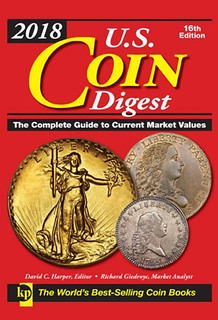 Easy to use and easy to understand, the 2018 U.S. Coin Digest is the most comprehensive color guide to United States coin issues on the market. Providing professionally vetted values,
complete coin listings, detailed coin images and unique "lay-flat" book design for no-sweat searches, U.S. Coin Digest is a superb reference for both the beginner and expert collector.
Easy to use and easy to understand, the 2018 U.S. Coin Digest is the most comprehensive color guide to United States coin issues on the market. Providing professionally vetted values,
complete coin listings, detailed coin images and unique "lay-flat" book design for no-sweat searches, U.S. Coin Digest is a superb reference for both the beginner and expert collector.
Inside you will find:
- All U.S. coin issues
- Real-market coin values
- 2,000 color images
- 11 grades of coin condition
- Bullion coins
- Private Gold coins
- Mint and Proof sets
- Commemoratives
- Coins of Hawaii, Philippines and Puerto Rico
- Colonial and Early Coinage
- Errors and varieties
Whether sorting through a jar of coins or appraising a massive collection, U.S. Coin Digest is the ideal reference for the job.
Author/Speaker/Editor David C. Harper, Editor; Richard Giedroyc, Market Analyst
Format Spiral Bound
ISBN 13 9781440247965
Number Of Pages 320
For more information, or to order, see:
2018 U.S. Coin Digest, 16th Edition (http://www.shopnumismaster.com/2018-us-coin-digest-16th-edition)
NEW BOOKS: THIRD REICH MEDALS AND HONORS
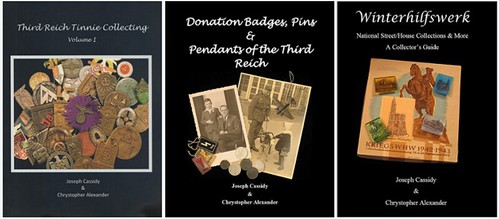
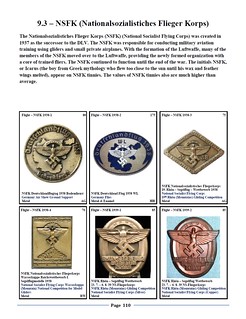 Third Reich Tinnie Collecting - Tinnies is the generic name for small commemorative pins and badges. While the name implies these badges are made of tin, that is not always the case.
The designers used all available materials: metal, wood, porcelain, clay, cloth, leather, and paper. Tinnies (Tagungsabzeichen), or Day Badges, commemorating an event have been around for as long as
organizers have felt a need to give or sell a remembrance of their event. Today, T-shirts or caps are the most common items issued as souvenirs of an event.
Third Reich Tinnie Collecting - Tinnies is the generic name for small commemorative pins and badges. While the name implies these badges are made of tin, that is not always the case.
The designers used all available materials: metal, wood, porcelain, clay, cloth, leather, and paper. Tinnies (Tagungsabzeichen), or Day Badges, commemorating an event have been around for as long as
organizers have felt a need to give or sell a remembrance of their event. Today, T-shirts or caps are the most common items issued as souvenirs of an event.
During the Third Reich, these souvenirs were tinnies. The Third Reich brought tinnie design and use to its highest point, issuing them for many and varied events. Each tinnie is a work of art, often designed by a master craftsman. They show the activities of the Third Reich and the history of Germany in a small package. The book has almost 3,100 color pictures of tinnies on 410 pages and translates the text of each tinnie from German into English.
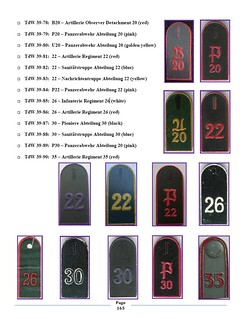 Donation Badges, Pins & Pendants of the Third Reich - When the Nazi regime took control of Germany in 1933, individual charitable organizations conducted their own street
collections. These organizations typically gave each contributor a token of thanks for their generosity. Desiring to bring these disparate charitable organizations under State control, the regime
designated the Winterhilfswerk des Deutschen Volkes (WHW) as the State charitable organization and started to exert control over these other charitable groups.
Donation Badges, Pins & Pendants of the Third Reich - When the Nazi regime took control of Germany in 1933, individual charitable organizations conducted their own street
collections. These organizations typically gave each contributor a token of thanks for their generosity. Desiring to bring these disparate charitable organizations under State control, the regime
designated the Winterhilfswerk des Deutschen Volkes (WHW) as the State charitable organization and started to exert control over these other charitable groups.
The smaller organizations had street collections with the accompanying tokens until about 1936, when they were folded into the Nationalsozialistische Volkswohlfahrt (NSV) (National Socialist People’s Welfare Organization). The larger groups, such as the Deutsche Jugendherbergwerk (DJH) (German Youth Hostels) and Deutsches Rotes Kreuz (DRK) (German Red Cross), were able to hold onto their identity and continued to have collections throughout the war, usually once a year. The other organizations tended to be special interest groups supporting a particular cause or agenda. The book has 1,200 different items in over 1,150 color photos on 316 pages.
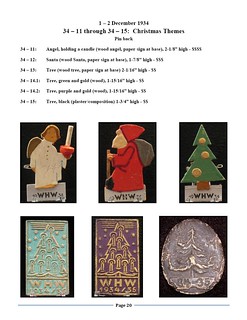 Winterhilfswerk Street/House Collections & More – A Collector’s Guide - As dedicated collectors, we worked diligently to assemble our individual collections of the tokens given for
donations to the German street and door to door charity drives organized by the Winterhilfswerk (WHW) organization. When we first started collecting WHW pieces, we did it without any reference
materials. As time went by, we realized the need for a guide to our collections to know what we had, what we needed, and the relative value of these items.
Winterhilfswerk Street/House Collections & More – A Collector’s Guide - As dedicated collectors, we worked diligently to assemble our individual collections of the tokens given for
donations to the German street and door to door charity drives organized by the Winterhilfswerk (WHW) organization. When we first started collecting WHW pieces, we did it without any reference
materials. As time went by, we realized the need for a guide to our collections to know what we had, what we needed, and the relative value of these items.
The references we found available were very informative, but they were naturally written in German. As English speakers with a limited knowledge of the German language, the use of these books often was difficult. As our collections progressed we found many other WHW collectors searching for an English language WHW guidebook. As the years passed and our wish for someone to publish a book in English went unfulfilled, we decided it was up to us to make our own wish come true. The next step to go through, the “If we had it our way we would . . .” process, was simple. The first feature would be color pictures. The second feature would be an index that told us where we could find a particular pin or set of pins without having to thumb through lots of pages. The third feature would be a large format so the pictures and print would be easier on the eyes.
This book does not contain pictures of every variant of every piece. It does contain at least one variant of every National WHW (598 different pieces) issued by the WHW street collections program from 1933 to 1944. By 1945, WHW collections and token distributions had ceased. Also contained are at least one variant of the paper door plaques (42 pieces) issued by the WHW door to door collection program between 1933 and 1940, WHW postcards, WHW stamps, and a WHW collection can. The total number of different items shown in this book is over 800, with over 550 color pictures on 132 pages.
For more information, or to order, see:
www.winterhilfswerk.com

REVISED BOOK: THE BANKOTE BOOK

If you're not already on The E-Sylum mailing list, subscribe today. It's a free weekly newsletter edited by Wayne Homren for the Numismatic Bibliomania Society, though you don't have to be a member to subscribe. The newsletter goes out by email every Sunday night to over 3,000 numismatic bibliophiles, researchers, and collectors around the world. Topics are all over the numismatic map, and most people find something of interest each week. Banknotes are frequently a topic along with news on a wide spectrum of numismatics and numismatic personalities.
Currently 252 chapters of The Banknote Book have been published as individual high-resolution PDF files. This represents a total of 3,890 pages covering 39,000 types and varieties. Revisions to the following have been published in the past week:
- Brazil (added listing for B874d)
- British North Borneo (added listing for B106d1/2)
- British West Africa (added Font Varieties table for B108p)
- European Monetary Union (added listings for B111e3, B111m3, B111v3, B111w3, B111z3)
- French Somaliland (added illustration for CCD signature 3; added listings for B128ap, B129ap, B301ap)
- Laos (updated prices throughout)
- Netherlands Antilles (added listings for B221bs, B222bs, B226i, B227h, B228h)
- Pakistan (added listing for B231o)
- Poland (added listing for B859b)
- Qatar (added listing for B217b)
- South Sudan (added listing for B111b)
- Vanuatu (added listings for BNP202, BNP203, BNP204)
- West African States (added listing for B120He)
- spreadsheet (added New 2017.04.29 sheet)
If you've previously purchased any of the above chapters, you are entitled to free revisions of your content for a period of one year following your purchase.
If you like what you've seen so far, please spread the word by telling others about The Banknote Book, but do not share or sell your PDFs. The Banknote Book is copyrighted and unauthorized distribution is piracy.
And remember, if ever you spot an error or omission, or if you have a suggestion for improvement, please let me know.
Sincerely,
Owen W. Linzmayer
P.O. Box 40159
San Francisco, CA 94140-0159
For more information, or to order, see:
http://banknotebook.contentshelf.com/shop
RED BOOK RECOLLECTIONS: DAVID LANGE
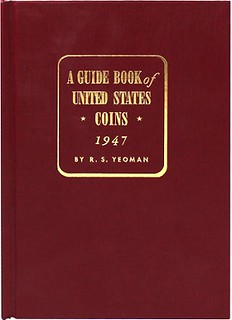 I received my first Red Book, the 22nd edition, for Christmas in 1968. Until that time I’d been using the Blue Book as my one-volume numismatic library. At the age of 10, I was only just
becoming aware of the difference between the two. I had already begun to memorize the mintages and values for my favorite coins, such as Lincoln cents and Buffalo nickels, and my acquisition of this
new and more powerful tool only added to my hobby enjoyment.
I received my first Red Book, the 22nd edition, for Christmas in 1968. Until that time I’d been using the Blue Book as my one-volume numismatic library. At the age of 10, I was only just
becoming aware of the difference between the two. I had already begun to memorize the mintages and values for my favorite coins, such as Lincoln cents and Buffalo nickels, and my acquisition of this
new and more powerful tool only added to my hobby enjoyment.
About 15 years later, I began to assemble a complete set of Red Books, a project which took me two years or so. The fifth edition was the toughest one, then as now, and I had to buy this and the first edition from numismatic literature dealers. I managed to find most of the others from a variety of sources, such as used book stores and coin club book sales, and putting the set together cost me much less than it ultimately was worth.
I’ve been present to receive nearly all of the special commemorative editions of the Red Book distributed during ANA conventions, though sadly I missed out on the first one, at the 1986 Milwaukee gathering, because of a work-related commitment. At the 1987 ANA convention in Atlanta, I had R.S. Yeoman sign my first edition, as well as the then-current 41st edition. The following year, at the ANA Summer Seminar in Colorado Springs, I again asked Mr. Yeoman to sign my new Red Book, released that very day, and I snapped a photo of him signing a copy for the person ahead of me in line. Little did I know that this would be among the last occasions that he would perform this satisfying ritual, for Dick Yeo (as I later learned his real name was) passed away not long afterward.
As a serious collector of the United States coinage for the Philippines, I was frustrated by the fact that these historic issues were not included in the Red Book. Having come to know editor Ken Bressett fairly well, I repeatedly asked him when these could be added to the lineup, and he assured me that they would whenever the page count permitted a new signature to be added to the book. This time came in 1998, and it was my honor to write the introduction to this series, which has appeared ever since. Coins from my own collection were the plate pieces for this chapter, though a few images have been replaced with sharper ones since then.
I’ve continued on as a contributor to the Red Book in a number of small capacities since that time, and I’m very pleased to see how the book has been expanded and greatly improved in recent years. It goes to show how a good thing can indeed continue to get better with age.
To read the complete article, see:
Red Book Recollections: David W. Lange (http://news.coinupdate.com/red-book-recollections-david-w-lange/)
THE BOOK BAZARRE
IMAGE-BASED ROMAN COIN IDENTIFICATION
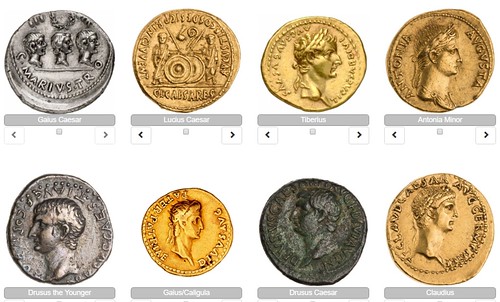
The American Numismatic Society (ANS) is pleased to announce a new interface for Online Coins of the Roman Empire (OCRE), which allows non-specialists, hobbyists, collectors, archaeologists, and others to browse Roman Imperial coins by image for free online. People can compare the coins in their collections or those coins recovered from archaeological excavations against diagnostic specimens in OCRE. The OCRE project received $300,000 from the National Endowment for the Humanities (NEH) in 2014.
The "Identify a Coin" interface works on any device, from computers to tablets to smart phones. Users can begin browsing Roman Imperial coinage right away, or can filter results by portrait, material, and even legends, which includes the ability to enter all or part of a legend as well as marking illegible characters. The portraits are listed chronologically, first by dynasty, and then by personage within the dynasty (including empresses and children). In many cases, examples of portrait images are available in gold, silver, and bronze varieties, as well as worn examples that one may encounter with stray finds or excavation. More than one material may be chosen, which is useful for later Roman coinage, when severe wear makes it difficult to distinguish between what Roman Imperial Coinage has designated as "silver," "bronze," or "billon." By clicking the left and right arrows below the image, it is possible to scroll through available portraits, which may show several phases of portraiture, such as Nero, who grew from a teenager into adulthood over the course of his reign.
OCRE’s "Identify a Coin" tool is one of the most complete depictions of numismatic Imperial portraiture online, and the ANS hopes that it will also prove itself a useful art historical tool to trace the development of Roman portraiture from the Augustan period through the Soldier Emperors to the Tetrarchy until the end of the Roman Empire.
Ethan Gruber, the ANS’s Director of Data Science, created the interface, and ANS Curatorial Assistant Disnarda Pinilla identified all of the portraits used in the tool. The ANS’s Associate Curator, Gilles Bransbourg, has overseen the OCRE project from its inception. Although primarily drawn from the ANS’s permanent collection of Roman Imperial coins, other specimens are included from the Münzkabinetts in both Berlin and Vienna, as well as from the Fralin Museum at the University of Virginia.
To access the ORCE identification tool, see:
http://numismatics.org/ocre/identify
To read the complete press release, see:
New Image-Based Roman Coin Identification (http://numismatics.org/newocreinterface/)
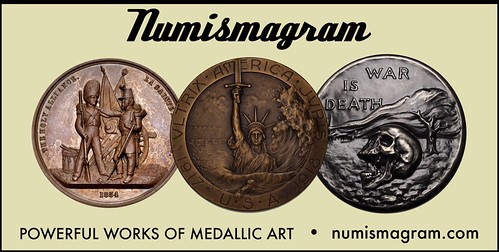
TEICHMAN INDEXES VIRGIL BRAND LEDGERS AT ANS
Saul Teichman Indexes Virgil Brand Ledgers at American Numismatic Society
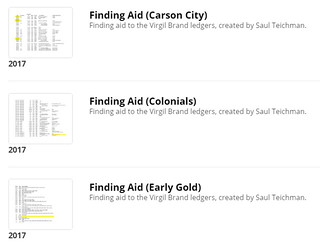 The Virgil Brand ledgers at the American Numismatic Society (ANS), an inventory of one of the most important American collections, are a frequently consulted resources at the ANS library.
The main ledger acts as a summary of the entire collection, while the 23 secondary ledgers provide additional detail on each coin. The Newman Portal and the ANS previously collaborated on the
scanning of these ledgers, which, in total, describe over a hundred thousand items. Now that this material is accessible online, Saul Teichman has meticulously created an index that details several
thousand of the most significant pieces listed in these massive, oversized volumes.
The Virgil Brand ledgers at the American Numismatic Society (ANS), an inventory of one of the most important American collections, are a frequently consulted resources at the ANS library.
The main ledger acts as a summary of the entire collection, while the 23 secondary ledgers provide additional detail on each coin. The Newman Portal and the ANS previously collaborated on the
scanning of these ledgers, which, in total, describe over a hundred thousand items. Now that this material is accessible online, Saul Teichman has meticulously created an index that details several
thousand of the most significant pieces listed in these massive, oversized volumes.
The result is eight finding aids, each dedicated to a specific area – Carson City coinage, colonials, early U.S. gold, medals, patterns, proof gold, U.S. rarities, and territorial coinage. These indexes illuminate the acquisitive, insatiable nature of Brand, whose middle name might well have been “Duplicate.” Why settle for a single 1827 quarter when you can have nine of the 18 known? Teichman has generously made these indices available through the Newman Portal, and collectors and researchers alike may now more easily search for provenance clues that could extend the story of a coin back into the 19th century.

1. Acquisition of 1827 25c listed in the Brand ledgers, #10436, purchased in 1893 at $150.00
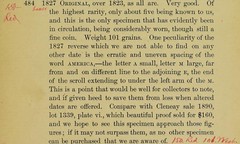
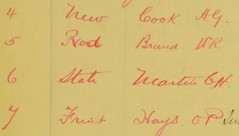
2. Same coin offered in the Chapman sale of the Petry collection 5/8/1893 (Chapman bid book copy from Hamelberg library)
3. Virgil Brand identified as winning bidder (“Red”), from the Chapman bid book
Link to Virgil Brand Ledger indices on Newman Portal:
https://nnp.wustl.edu/library/archivedetail/513927?Year=2017&displayAmt=50
Saul's efforts are exactly the sort of volunteer "crowdsourcing" efforts the numismatic community can provide to enhance the utility of materials made available by the Newman Portal. Thank you!
Saul Teichman adds:
There are large data gaps in what is presented, especially for Colonials (over 1500 pieces are missing and this is not an area of expertise for me) and probably patterns as the Dr Hall, Wurtzbach and Brenner purchases are not itemized in the journals.
I am hoping some of this data is available in the Brand papers and invoices that have not yet been published on the Newman portal.
The one for medals is primarily US gold medals, although I do note the two Richardson oval Indian Peace Medals purchased in the Hunter sale and the Stickney Season medal set that appeared in the Bowers & Merena Brand II sale.
The early gold includes a listing of journal #s for the Bechtlers, which I did not bother to itemize in the Territorial section – I only highlighted major purchases (bulk purchases) in that one.
If anyone finds errors or can provide updates to these listings they should send them to me at saul.teichman@ey.com.
I am certainly no expert on colonial coins, for example, so I could easily have made mistakes in this listing.
Another sort of crowdsourcing involves scouring the community for the source materials themselves - not all resources are found in major repositories like the ANS and Eric P. Newman numismatic libraries.
Len reports getting a request for Randolph Zander fixed price lists. Zander was based in Alexandria, VA. A group of his publications was sold in Remy Bourne's 14th numismatic literature sale (and thanks to Remy for allowing his sales to be digitized by the portal, enabling this discovery).
Lot 463 in that sale contained 175 of Zander's early world coin price lists and mail bid sales issued beteen 1955 and 1975. Could anyone lend these to the Newman Portal for digitization? Is there a known current copyright holder? Thanks. -Editor
To read the complete lot description, see:
https://www.archive.org/stream/publicauction142001bour#page/n61/mode/2up
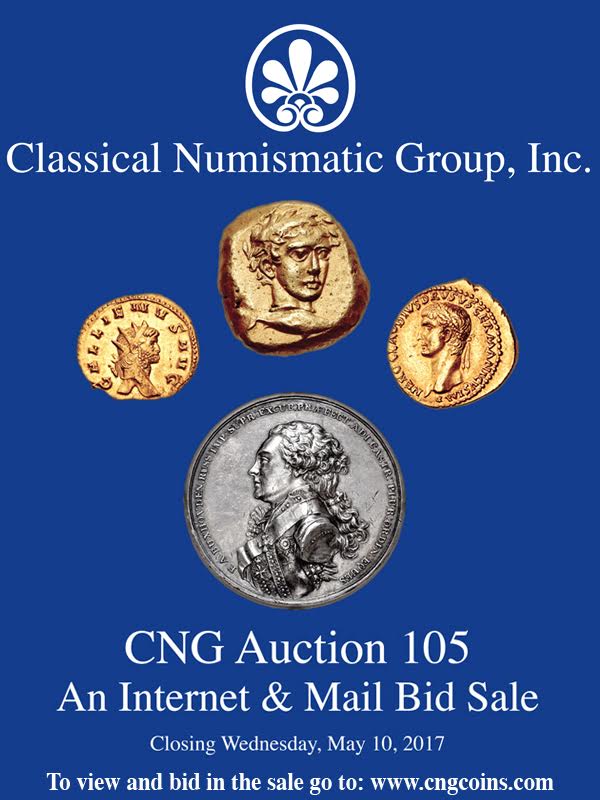
NOTES FROM E-SYLUM READERS: MAY 7, 2017
More on Calendar Medals
Over the years I have seen many different types of calendar medals, the earliest dating to the Columbian Exposition 1892-3. Typically perpetual calendar medals relate to a range of years, such as this one:
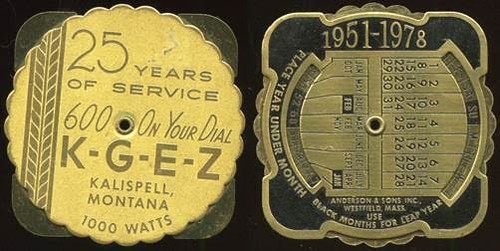
But this very unusual perpetual calendar (even labeled as such!) pertains only to the days/dates for a single month!
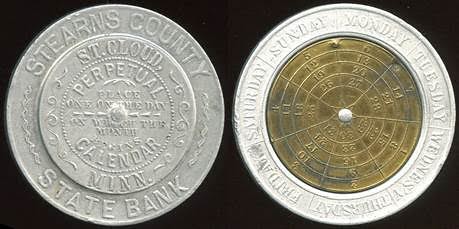
Both of these perpetual calendars will be offered in my upcoming exonumia auction closing to advance bidding on June 24. Copies of the auction listing when it becomes available can be requested at collector.ca@frontier.com.
To read the earlier E-Sylum articles, see:
VOCABULARY TERM: CALENDAR MEDAL (www.coinbooks.org/v20/esylum_v20n17a16.html)
NOTES FROM E-SYLUM READERS: APRIL 30, 2017 : More on the Perpetual Calendar Medal (www.coinbooks.org/v20/esylum_v20n18a09.html)
On Banknote Quote Punctuation
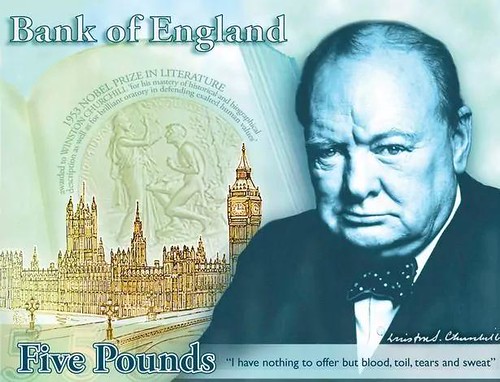
Concept design

Final design
Regarding the punctuation (or lack thereof) on the Churchill quote on the new Five Pound note, Arthur Shippee writes:
Another factor: how much ink is saved by omitting QM, period, & comma? Maybe a lot!
To read the earlier E-Sylum article, see:
BANKNOTE CHURCHILL QUOTE DRAWS CRITICISM (www.coinbooks.org/v20/esylum_v20n18a29.html)
1931 Carnegie Hero Medal
Dave Schenkman writes:
My wife Joanne and I were watching Antiques Roadshow, no doubt a rerun, and they featured a Carnegie medal awarded, along with a $1000 check, in 1931. The “expert” placed a value of $4,000 on the medal (which was bronze); seems a bid high…
To watch the episode online, see:
1931 Carnegie Hero Medal
(www.pbs.org/wgbh/roadshow/season/19/chicago-il/appraisals/1931-carnegie-hero-medal--201406A19/)

U.S. MINT INTERVIEW ON APOLLO 11 DESIGNS
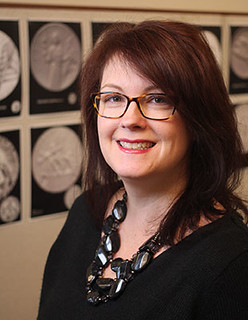 collectSPACE spoke with April Stafford, chief of the Mint's Office of Design Management, to learn more details about the 2019 Apollo 11 50th Anniversary Commemorative Coin Design
Competition.
collectSPACE spoke with April Stafford, chief of the Mint's Office of Design Management, to learn more details about the 2019 Apollo 11 50th Anniversary Commemorative Coin Design
Competition.
collectSPACE (cS): Why a design competition over an in-house designer? The provision for the contest was written into the bill that authorized the commemorative coins. Was that something suggested by the Mint to Congress?
April Stafford: The Mint does not suggest or request that provisions be added to a bill. The U.S. Mint is required to administer all programs according to legislation enacted by Congress and signed into law by the President.
Accordingly, the sponsor of the Apollo 11 50th Anniversary Commemorative Coin Act added the competition provision, which lawfully requires that the Mint execute the program as so.
cS: How does this design competition differ, if at all, from past competitions held by the Mint?
AS: The structure of the competition is similar to those the Mint has recently held.
During Phase One, which is open to the public from May 1 through June 29, artists will submit three to five samples from their existing portfolio, along with contact information. This can be uploaded to the Mint's website. The portfolios will be evaluated by an expert jury. From there, the jury will choose no more than 20 artists to take part in Phase Two.
What is different with this competition is that during Phase Two, finalists only need to submit a two-dimensional digital design. Recent competitions have required or suggested a three-dimensional model be part of the entry.
For this competition, a three-dimensional model will not be accepted due to the complexity of sculpting on a curved basin. Also of note, those invited to take part in Phase Two will be paid a stipend of $500.
cS: On average, how many entries have been received in prior two-phase competitions?
AS: The Mint does not disclose the number of responses for past competitions. But we have been very pleased with both the quantity and quality of the entries.
cS: What is special about the four coins in the Apollo 11 50th anniversary commemorative program?
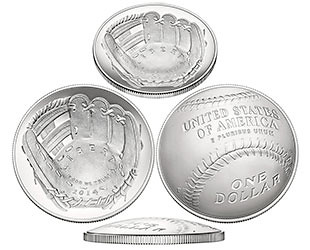 AS: All four Apollo 11 coins are curved, which, given the subject matter, will make for very engaging artistic designs. Also special is that this is the first time in recent years
that a U.S. Mint commemorative coin program has more than three coins.
AS: All four Apollo 11 coins are curved, which, given the subject matter, will make for very engaging artistic designs. Also special is that this is the first time in recent years
that a U.S. Mint commemorative coin program has more than three coins.
Finally, the fourth coin in this program is a 5 ounce version. The U.S. Mint has never produced and offered a curved 5 ounce coin in its history, so that will add to the excitement as well.
cS: The U.S. Mint advises on the competition website that artists should resist basing their designs on photos. Since NASA imagery (e.g. the photos taken on the moon) is in the public domain, can they be used for inspiration?
AS: The design of the coins' obverse (heads side) should be emblematic of the United States space program leading up to the first manned moon landing.
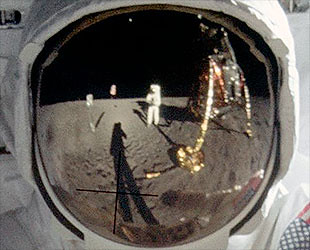 Inspiration for this program, and all coin designs for that matter, can be taken from photos, video, audio, personal memories or anything that inspires an artist. However, the design must
be the artist's original work and not be based on pre-existing work, whether it is in the public domain or not.
Inspiration for this program, and all coin designs for that matter, can be taken from photos, video, audio, personal memories or anything that inspires an artist. However, the design must
be the artist's original work and not be based on pre-existing work, whether it is in the public domain or not.
It's also important to note that the designs may not include the name or depiction of any living person – including an astronaut – even with permission.
AS: The U.S. Mint will not be sharing publicly the designs submitted by the finalists. However, the legislation for this competition requires that the designs be reviewed by the two federal advisory committees — the Citizens Coinage Advisory Committee (CCAC) and the U.S. Commission on Fine Arts. As these committees hold public meetings, the designs will be released to the public on the date of those meetings.
The submissions will be released anonymously; the names of the submitting artists will not be released.
cS: The jury comprises members of the CCAC and Fine Arts Commission, as well as a U.S. Mint representative. Notably absent is someone from NASA or someone who has direct knowledge of space history. Will there be such a person or persons who will assist the Mint and/or jury to ensure historical accuracy?
AS: Yes, there will be subject matter experts available to advise the jury on historical and technical accuracy during the judging process. In fact, the legislation stipulates the Mint work with the Administrator of NASA or a designee on the reverse for this coin. The Mint plans to leverage this expertise also for a review of the obverse design.
For more details, see the 2019 Apollo 11 50th Anniversary Commemorative Coin Design Competition website: https://www.usmint.gov/news/design-competitions/apollo-11
To read the complete article, see:
US Mint launches public art competition to design Apollo 11 moon landing coins
(www.collectspace.com/news/news-050117a-apollo11-50th-anniversary-coin-design.html)
To read the U.S. Mint Press Release, see:
United States Mint Launches Public Design
Competition for Program Marking 50th Anniversary of Apollo 11
(www.usmint.gov/news/press-releases/united-states-mint-launches-public-design-competition-for-program-marking-50th-anniversary-of-apollo-11)

BRENNER'S 1895 ONE DOLLAR COIN DESIGN
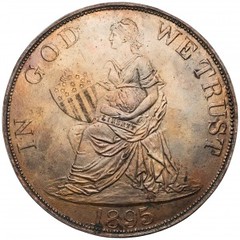
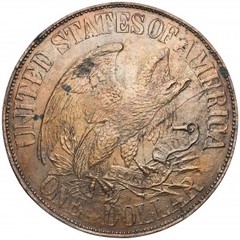
I was working on an article about George Kunz and the redesign of United States Coinage (ANS Magazine, 2017/1) when I came upon an interesting coin design in the ANS vault. It was an electrotype model of a U.S. dollar by Victor David Brenner, made about fourteen years before his actual contribution to the redesign of U.S. coinage, the iconic and ubiquitous Lincoln cent (1909). His was one of twenty-five dollar designs submitted for a competition in 1895, part of an organized effort at improving the nation’s much maligned coinage that was ostensibly carried out by several private art groups but was in reality undertaken mostly by two: the National Sculpture Society (NSS) and the ANS. The NSS showed real commitment to the cause, putting up all of the prize money: $300 for first place and either $100 or $200 for second (accounts vary). This was big money in 1895; first prize would be comparable to about $8,000 today.
Given that coins are small sculpted pieces used by nearly everyone, the promotion of high quality coinage was a natural undertaking for the NSS. The group was founded in 1893 to promote quality sculpted art to the masses. To help fulfill its civic-minded goals, it opened its membership to non-sculptors—administrators, businessmen, and others that might help the cause. Kunz, Tiffany’s resident gem expert, joined the group in its first year. He also joined the ANS in 1893, and it appears that he was the primary agent at both groups promoting coinage redesign, apparently with the backing of an influential party in Washington.
The dollar designs that were submitted for the competition were displayed at an exhibition of ancient and world coins and medals at the American Fine Arts Building on 57th Street in New York City. The show was curated by the ANS and was intended to show historical examples of quality artistic coinage. Brenner did not win. First prize went to Albert Jaegers, specifically for the eagle on his reverse. Albert Randolph Ross came in second, for his obverse showing Liberty and a turkey. The prizes had no official standing and the two artists would play no role in the actual coinage redesign that began a decade later.
To read the complete article, see:
VICTOR DAVID BRENNER’S DESIGN FOR A U.S. DOLLAR
(http://numismatics.org/pocketchange/victor-david-brenners-design-for-a-u-s-dollar/)
VOCABULARY TERM: DIAPER
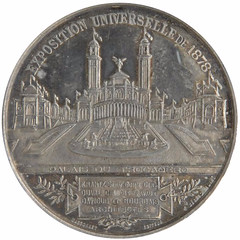
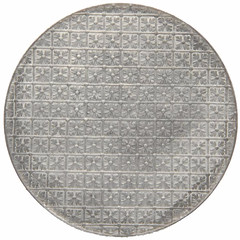
Instead of a blank die early die makers occasionally used a die with a substitute design when proving a new die when its mated die was not available. Each die maker had his own diaper die design.
Diaper. A design of repeated elements, usually fitting within one another to form a consistent pattern that occupies the entire flan of a struck numismatic piece. As
a medallic design it is monotonous and generally lacks any relationship to the opposite side of the struck piece. The practical use of a diaper die is to replace a blank die or jack die during
proving, where it indicates a design is intended to appear on that side but perhaps is not yet ready. As such a diaper design indicates the piece is a die trial. The term derives from the name of a
cloth with such a textured pattern first made during the Renaissance.
CLASS 04.4
Reference:
S5 {1974} Stafford and Ware, 73.
Looking for the meaning of a numismatic word, or the description of a term? Try the Newman Numismatic Portal's Numismatic Dictionary at: https://nnp.wustl.edu/library/dictionary

WILLIAM PENN BROWN (1841-1929)
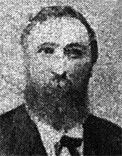 William Penn Brown (1841-1929), was born on December 12, 1841, in Assam, India, son of Rev. Nathan Brown, Jr., (1807-1886), a missionary native of Vermont and Eliza Whitney Ballard
(1807-1871), a native of Massachusetts. His early years were lived with his missionary parents in Yokohama, Kanagawa, Japan.
William Penn Brown (1841-1929), was born on December 12, 1841, in Assam, India, son of Rev. Nathan Brown, Jr., (1807-1886), a missionary native of Vermont and Eliza Whitney Ballard
(1807-1871), a native of Massachusetts. His early years were lived with his missionary parents in Yokohama, Kanagawa, Japan.
He is considered the first American stamp dealer who began in 1859, though he considered himself second to James Brennan. He was a dear friend of John Walter Scott and introduced him to philately and in 1860 helped him with finances sufficient enough to open a stamp business.
In 1859, at City Hall Park, New York City, William P. Brown began to sell postage stamps at a stand. He was inspired by previously selling the foreign stamps mailed to him on envelopes from foreign correspondents to the postal clerks who wanted to collect them. They were not alone. There was an interest in the general population. Crowds used to gather in the corridors of the old Post Office, Nassau and Liberty Streets, to buy and exchange stamps. It is possible that to avoid congestion in a public building the crowds were asked to move outside and conduct their affairs off the premises.
Some have recently speculated that George Hussey, owner of the Special Message Post, and one of his letter carriers James Brennan were the first two stamp dealers in America. It may be. It seems virtually impossible to ascertain as to the day and hour who was the very first stamp dealer in America. In a more sober approach, without splitting hairs, it is safe to say that George Hussey, James Brennan, and William P. Brown began dealing about the same time. William P. Brown erected a small stand at the Park and sold postage stamps discovering the market and demand was bigger than one could have guessed. The rest is history.
In 1860, Brown expanded his business of stamp dealing to include a full array of U. S. and foreign coins, medals and tokens.
In 1870 he lived with his parents and sister Elizabeth in Jersey City, New Jersey. Brown was an innovative pioneering curiosities, coin, and postage stamp dealer, and publisher of De Kuriositi Kabinet (Sept 1870 – Aug 1871), with orthography based on The American Philological Society changed title to Curiosity Cabinet which ran until October 1884; Tiffany No. 20. Kuriositi Kabinet was printed in some text that Ebenezer Locke Mason, Jr., identifies as Old Saxon revived by the American Philological Society in the 1860’s, a pseudo-precursor to Esperanto (1887).
Brown purchased 16,000 foreign coins from Mr. King of London cited in Mason's Coin and Stamp Collectors Magazine, Vol. V, August (1871) : 127,
Brown was a donor in 1878 to the ANS library.
Ebenezer Locke Mason, Jr., mentions visiting Brown's stamp & coin shop in the beginning of May, 1879 after stopping in at Bangs & Co., attending the Michael Moore coin auction sale catalogued by Ed Cogan. Apparently, during that visit he was given an advertisement from Brown to have Mason publish it in his next issue of Mason's Coin Collectors' Herald.
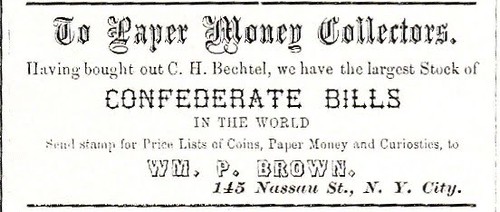
E. F. Gambs, a coin and stamp dealer at St. Louis, Missouri, [later at San Francisco, California] wrote a letter to Ebenezer Locke Mason, Jr., which he published in his magazine and titled the letter : "The 1802 Half Dime," Mason's Coin Collectors' Herald, Vol. I, No. 3, December (1879) : 26a-c. Gambs says he discovered the finest 1802 Half Dime in the country about October 1877. He wrote to both John W. Haseltine and William P. Brown sending them rubbings. Each replied informing him the same thing that the best price had was at the Ed Cogan auction of the E. Harrison Sanford sale on November 27, 1874 held at Bangs & Co., New York, realizing $47.50.
Since Gambs was already a frequent customer of Brown he sent the coin to him on approval by registered mail specifying his lowest acceptable price. Brown promptly paid him the asking price of $25.00. Gambs said he was very pleased until he learned that Brown sold it at auction and realized $147.50. However, Brown graciously wrote to Gambs immediately after the sale and generously gave him an additional $25.00 in credit.
His 4th floor office, Room 37, on Nassau Street, which he shared with a Mr. D. P. Lindsley, was destroyed by a fire that broke out at 10:12 pm on January 31, 1882 putting him out of business for a while.
On March 20, 1882, John Walter Scott, sold the 600 lots of coins remaining of the stock of William P. Brown from the fire. Scott wrote a "large and valuable assortment of American and foreign coins, the entire remainder of the stock saved from the great fire in the Porter building, the property of the well known dealer William P. Brown." "In many respects this is the most peculiar lot of coins ever offered at public auction."
He died December 30, 1929. He was 88 years old.
To read the complete article, see:
BROWN, WILLIAM PENN
(https://sites.google.com/a/numismaticmall.com/www/numismaticmall-com/brown-william-penn)
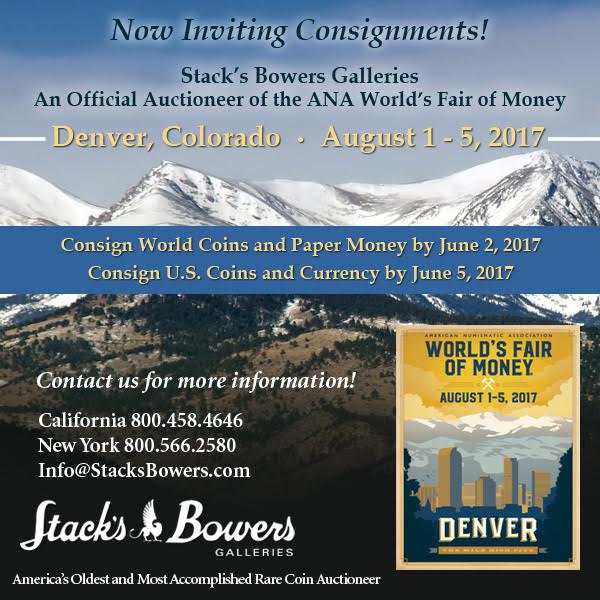
CONRAD MOWER NIELSEN (1922-2008)
CM Nielsen - Philippine Collector Extraordinaire
 Conrad Mower Nielsen (18 March 1922 - 10 August 2008) was an expert in the field of Philippine numismatics, especially emergency war ("guerrilla") notes. He was better known as CM
Nielsen or simply Niel. During his lifetime, he amassed what was possibly the largest private collection in the world. Only the notes held by Museo Sugbu (Cebu Provincial Museum) in the Philippines
is believed to be a larger collection.
Conrad Mower Nielsen (18 March 1922 - 10 August 2008) was an expert in the field of Philippine numismatics, especially emergency war ("guerrilla") notes. He was better known as CM
Nielsen or simply Niel. During his lifetime, he amassed what was possibly the largest private collection in the world. Only the notes held by Museo Sugbu (Cebu Provincial Museum) in the Philippines
is believed to be a larger collection.
He was born in Fairview, Utah, and was the youngest of five sons of Carl and Inger Hansen Nielsen. His mother passed away just 12 days after his birth. He enlisted in the civilian pilot training unit of the air corps in December, 1942, at Santa Ana air base, California. He was discharged in 1943, and immediately enlisted in the Merchant Marine. He was awarded the Pacific War Zone Bar, Atlantic War Zone Bar, Mediterranean Middle East War Zone Bar, Philippine Liberation Ribbon and, years later, the Vietnam Service Bar.
His first numismatic experience was acquiring some "guerrilla" paper money when dropping off supplies from his ship somewhere in the Philippines. Since his ship was frequently in the Philippines, he was able to acquire many pieces and examples of this "guerrilla" money.
He had a secret hiding place, for all his notes and other materials, which was under his house. He had dug out a bunker-like room under one of the bedrooms; in order to enter it, you had to lift up the floor in a closet, go down a ladder and then walk into the closed room. All of the walls were lined with shelves and the boxes were FULL of notes from everywhere in the world, especially during WWII. But most were Philippine guerrilla notes. If he had dumped it on the market, many notes would have lost a lot of value in other collections!
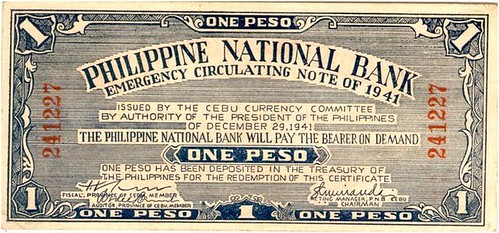

From his research, he wrote the Philippine section in Krause's Standard Catalog of World Paper Money/Specialized Issues in the early 1980's. Unfortunately, he was an exacting and somewhat secretive individual when it came to research and only published a few articles. So, today, much of it remains unpublished and, with his death, is lost forever. Ken Berger, with help from Neil Shafer, Ray Czahor, and Jimmie Steelman, has been attempting to salvage just one small aspect of his research. Luckily, this is possible because right before his passing, his entire collection of war notes, coins, stamps, books and research material was acquired by Ray Czahor of Cookie Jar Collectibles.
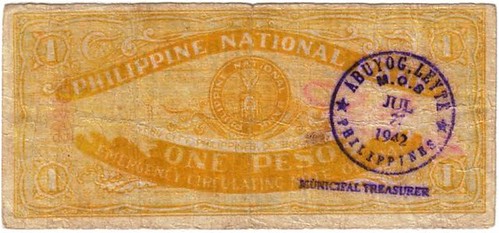
with an Abuyog, Leyte counterstamp
Ken adds:
Thanks to Howard Daniel for providing the above photo of C.M. Nielsen. I am still looking for other photos - please let me know if you have one or know where I might find one.

THE BRITISH MUSEUM MONEY MATTERS EXHIBITION
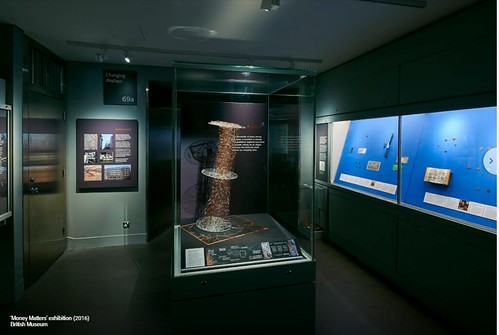
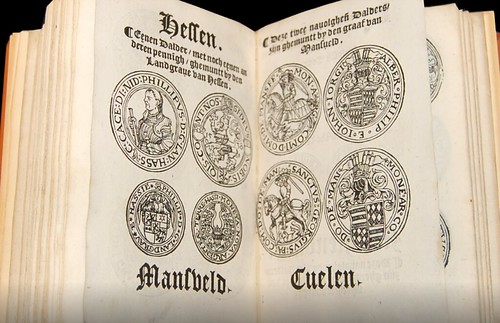
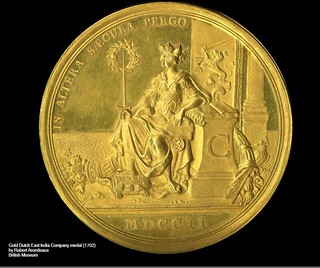
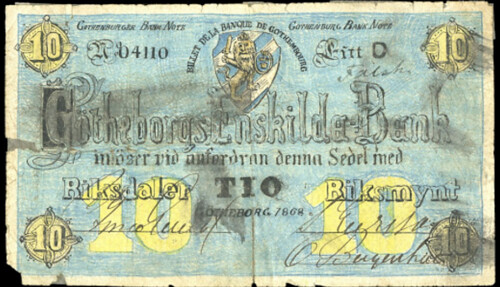
To see the complete exhibit, see:
Money Matters (www.google.com/culturalinstitute/beta/u/0/exhibit/0gJSaMG8uxpTIw)
For more information on the exhibit, see:
Money matters 3 June – 9 October 2016
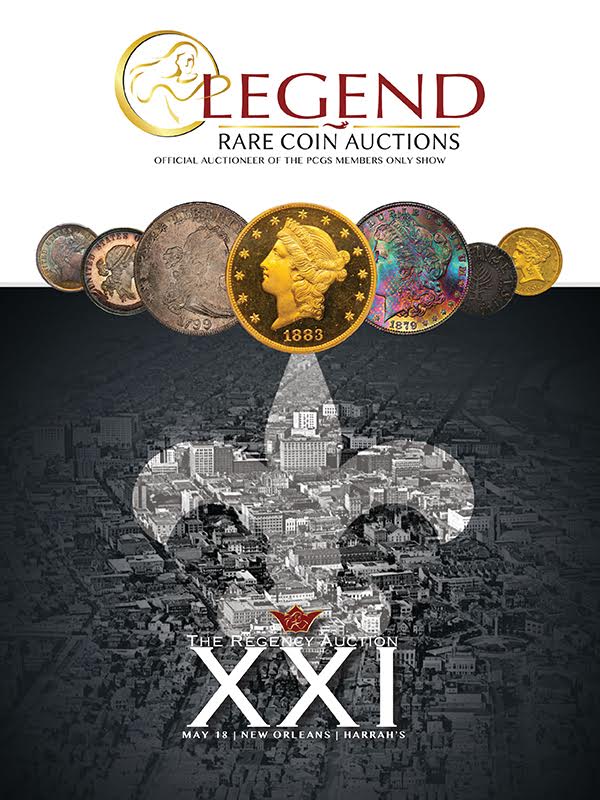
SELECTIONS FROM NUMISMATICA ARS CLASSICA #99-100
Shanna writes:
Here are just some of the fantastic pieces coming up at the NAC auction on May 29-30. I’ve only highlighted some of the coins. The biggest thing I noticed is that most of the major “star” pieces in ancient numismatics exist in this sale and there are several six figure coins. The only significant coin that it didn’t have from my mind is an EID MAR, otherwise, pretty much everything that gets people excited in Greek and Roman coinage is there.
Auction 99 is the second part of the George LaBorde collection. This group of 50 aureii completes the sale of Mr. LaBorde’s coins. He collected only aureii and purchased several with significant pedigrees which makes the collection very exciting. Here are a few of the notable coins
Lot 5: Galba Aureus
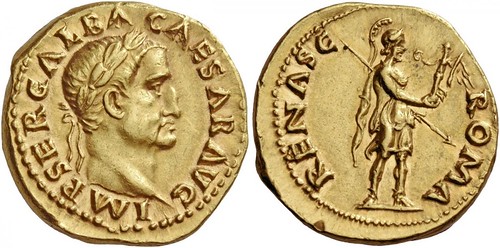
Galba, 68 – 69. Aureus July 68-January 69, AV 7.31 g. IMP SER GALBA CAESAR AVG Laureate head r. Rev. ROMA RENASC Roma, helmeted and in military attire, standing r., holding Victory on globe and transverse spear. C 199. RIC 198. BMC –. Calicó 491 (this coin illustrated). Extremely rare and in exceptional condition for the issue. A very appealing portrait perfectly struck and centred on a full flan and an interesting reverse composition. Good extremely fine
This coin is illustrated on the back cover of David R. Sear’s, Roman Coins and Their Values: Vol. I.
To read the complete lot description, see:
Galba, 68 – 69. Aureus July 68-January 69, AV 7.31 g
(https://sixbid.com/browse.html?auction=3503&category=74072&lot=2914253)
Lot 32: Aurelian Aureus
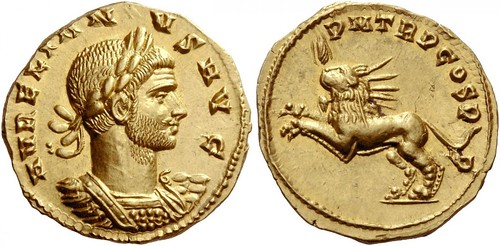
Aurelian, 270 – 275. Aureus, Cyzicus early 272, AV 4.84 g. AVRELIAN – VS AVG Laureate and cuirassed bust r., with slight drapery on l. shoulder. Rev. P M TR P COS P – P Radiate lion leaping l., holding thunderbolt in its jaws. C –. RIC 159 (Siscia). Göbl Aurelianus, 129An2 and pl. 75 (Roma, this reverse die). CBN p. 416 and pl. 85, 259 (this reverse die). Calicó 4022 (this coin). Extremely rare and possibly the finest specimen known. An important and interesting issue with a spectacular reverse type. Virtually as struck and almost Fdc
To read the complete lot description, see:
Aurelian, 270 – 275. Aureus, Cyzicus early 272, AV 4.84 g
(https://sixbid.com/browse.html?auction=3503&category=74072&lot=2914280)
Lot 44: Carausius Aureus
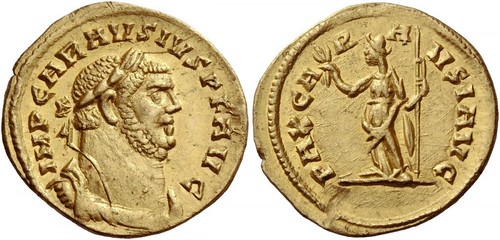
Carausius, 286 -293. Aureus, Londinium October 286-March 287, AV 4.20 g. IMP CARAVSIVS P F AVG Laureate, draped and cuirassed bust r. Rev. PAX CA – R – A VSI AVG Pax standing l., holding olive branch and vertical sceptre. C –. RIC 5. Depeyrot 2/5. Shiel 4. Calicó 4782.
Of the highest rarity, apparently the second specimen known. An unusually attractive portrait struck on a full flan, minor mark on reverse field at seven o’clock, otherwise good extremely fine / extremely fine
To read the complete lot description, see:
Carausius, 286 -293. Aureus, Londinium October 286-March 287, AV 4.20 g
(https://sixbid.com/browse.html?auction=3503&category=74072&lot=2914292)
Shanna writes:
Auction 100 is a marvelous sale with countless Greek and Roman highlights. Just a few highlights are lot 24, a signed tetradrachm from Akragas, lot 87, a Naxos tetradrachm, lot 96, a Sicily, Syracuse signed tetradrachm, lot 99, 100 and 102 are three beautiful dekadrachms of Syracuse (two are signed). Lot 126 is a didrachm from Samothrace that comes from the Kunstfreund collection and is from an early hoard.
Lot 134 is an Athens dekadrachm. These normally are not available and authenticity can be questionable. This one is certainly from the hoard that was found in Turkey in the 1980’s. A number of European and American dealers (including my father, Harlan Berk) got parts of this hoard. In the end the Turkish government had all the coins returned and some of them did not make it back to Turkey and were put away. None of this is a secret. It was highlighted in a July 1988 Connoisseur magazine article (I have a copy of the article should you want it). Lot 134 is certainly the coin that my father did not return and was noted in the article. The question of authenticity is therefore very small.
Lot 148 is a fantastic electrum stater that is a duplicate from the Hermitage museum in St. Petersburg.
Lot 170 is a First Revolt year 5 shekel of which only a handful exist.
Lot 87: Naxos Tetradrachm
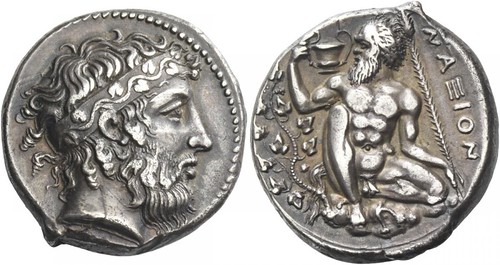
Naxos. Tetradrachm, circa 415, AR 17.14 g. Bearded head of Dionysus r., hair bound with stephane adorned with ivy-wreath. Rev. Bearded, naked Silenus, with pointed ears, ruffled hair and long tail, squatting on rock, facing; r. leg raised and l. folded to the side. He turns l. towards cantharus in his r. hand, while holding thyrsos in his l. In l. field, ivy plant creeps upward, behind which his long tail is visible; to r., NAΞION. Rizzo pl. XXX, 1 (this reverse die). Jameson 677 (these dies). Gulbenkian 232 (these dies). SNG Fitzwilliam 1113 (these dies). Dewing 663 (this obverse die).
Very rare and among the finest specimens known of this spectacular and desirable issue. A wonderful portrait in full Classical style and a very appealing reverse composition. Perfectly struck and centred on a full flan and with a magnificent old cabinet tone. Extremely fine
To read the complete lot description, see:
Naxos. Tetradrachm, circa 415, AR 17.14 g. Bearded head of Dionysus
(https://sixbid.com/browse.html?auction=3509&category=74102&lot=2917743)
Lot 102: Syracuse Decadrachm signed by Euainetos
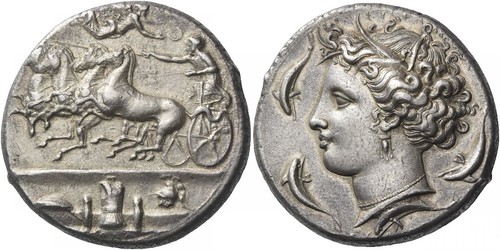
Syracuse. Decadrachm signed, by Euainetos circa 400 BC, AR 42.71 g. Fast quadriga driven l. by charioteer, holding reins and kentron; in field above, Nike flying r. to crown him. In exergue, display of military harness set on two steps and below l., [Α]ΘΛΑ. Rev. ΣΥ – ΡΑ – Κ – [Ο – ΣΙΩΝ] Head of Arethusa (Kore-Persephone) l., wearing barley-wreath, triple pendant earring and beaded necklace. Around three dolphins, while a fourth makes dorsal contact with neck truncation; beneath, EY – AINE. SNG Copenhagen 689 (this reverse die). Dewing 880 (these dies). Gallatin C.IV/R.III. Rare. A superb specimen of this desirable issue. Struck on a very broad flan and with a light iridescent tone. Extremely fine
Ex Tkalec sale 8 September 2008, 20.
Coins of the artist Euainetos are among the most exquisite works of art from the ancient Greek world. Of special value are his decadrachms, which must have been distributed widely, for they were
influential to artists in regions far removed from the shores of Sicily. It is unlikely that many were exported through the normal channels of commerce, and we might suggest that, much like the
staters of Olympia, some were acquired as keepsakes and were carried to a variety of destinations. The decadrachms of Kimon and Euainetos were introduced early in the reign of the tyrant Dionysius I
(405-367 B.C.), and those of Euainetos continued to be struck for decades, perhaps even beyond the 360s. We might presume that Dionysus took a personal interest in producing such large coins of fine
style to evince his patronage of the arts and to promote the success of his rule.
To read the complete lot description, see:
Syracuse. Decadrachm signed, by Euainetos circa 400 BC, AR 42.71 g.
(https://sixbid.com/browse.html?auction=3509&category=74102&lot=2917758)
Lot 134: Attica Athens Decadrachm
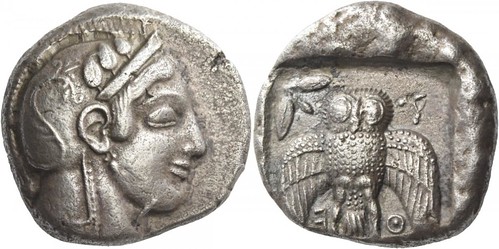
Attica, Athens. Decadrachm, circa 467-465, AR 41.98 g. Head of Athena r., wearing crested helmet, earring and necklace; bowl ornamented with spiral and three olive leaves. Rev. A – Θ – E Owl standing facing, with spread wings; in upper field l., olive-twig with two leaves and berry. The whole within incuse square. ACGC 188. Starr Group II C 61 (this obverse die). Svoronos pl. 8, 14 (this obverse die). Seltman pl. XXI, A 207 (this die). Kraay-Hirmer 358 (this obverse die). Fischer-Bossert The Athenian Decadrachm 28a (this coin). Extremely rare and of the highest numismatic and historical interest, undoubtedly one of the most prestigious Greek coins. Metal slightly porous and a die-break on obverse, otherwise good very fine / about extremely fine
Ex Berk 109, 1999, 191 and NAC 39, 2007, 41 sales. Athens decadrachms rank high among the prizes of ancient Greek coinage, with few examples existing in public or private collections. The purpose of these massive coins, and their dating, has long excited debate among scholars. In recent years a careful study of hoard evidence has shattered some enduring myths, and these coins are now attributed to a period of perhaps several years in the mid-460s B.C., making them contemporary with the ‘Demareteion’ decadrachms of Syracuse.
To read the complete lot description, see:
Attica, Athens. Decadrachm, circa 467-465, AR 41.98 g. Head of Athena
(https://sixbid.com/browse.html?auction=3509&category=74102&lot=2917790)
From the Roman section there are numerous coins that are interesting but a few highlights are: lot 374 (P. Clodius M.f. Turrinus aureus), lot 401 a cistophoric tetradrachm of Marc Antony and Cleopatra, lot 460 a sestertius of the Colloseum in Rome, lot 478 which is a fabulously struck Hadrian/divus Trajan aureus. Lot 549 and 555 are two perfect aurei from the Severan dynasty. There are also a few impressive large denomination solidii such as lot 637 (Medallion of Constantine I). Lot 690 is an unimprovable solidus of Procopius. Finally lot 725 is an exceedingly rare solidus Licinia Eudoxia which has a pedigree going back to 1924
Lot 374: Turrinus Aureus
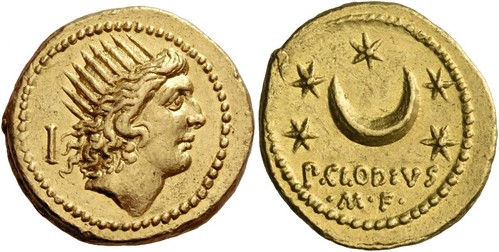
P. Clodius M.f. Turrinus. Aureus 42, AV 8.19 g. Radiate head of Sol r.; behind, quiver. Rev. P·CLODIVS / M·F Crescent surrounded by five stars. Babelon Clodia 16. Bahrfeldt 31. Sydenham 1114a. Sear Imperators 181a. Crawford 494/20a. Calicò 9. Very rare and in exceptionally good condition for the issue, undoubtedly among the finest specimens known. Struck on a very broad flan and perfectly centred. Extremely fine / good extremely fine
To read the complete lot description, see:
P. Clodius M.f. Turrinus. Aureus 42, AV 8.19 g.
(https://sixbid.com/browse.html?auction=3509&category=74103&lot=2918030)
Lot 460: Divu Titus Sestertius
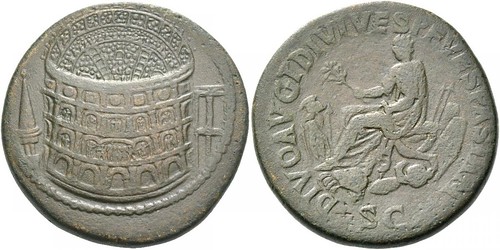
Titus, 79 – 81. Divu Titus. Sestertius 81-82, Æ 25.92 g. Aerial view of the Flavian amphitheatre (the Colosseum); on l., Meta Sudans and on r., porticoed building. Rev. DIVO AVG T DIVI VESP F VESPASIAN Titus seated l. on curule chair, holding branch and roll; around, arms; below, S – C. C 399. BMC 191 note. RIC Domitian 131. CBN Domitian 543. Elkin, NC 2006, p. 217, 9. Extremely rare, only the eleventh specimen known of this prestigious and important issue, which is much more rare with Titus as Divo rather than Emperor. A very detailed and clear obverse composition and a pleasant brown-green patina. As usual weakly struck on reverse, otherwise about extremely fine / very fine
From the Aba Neeman collection.
The most famous monument of Italy – if not of all Europe – is the Amphitheatrum Flavium, the Colosseum in Rome. Named after the emperor Vespasian (A.D. 69-79), who began its construction in 71, it
was Rome’s first permanent structure of the type, as all such events in Rome had previously been held in wooden structures.
Vespasian was still alive when the first three levels of his colosseum were completed and dedicated in 75. However, the final product – including the fourth and fifth levels, which are clearly represented on this sestertius – was not finished for another five years, at which point it was formally dedicated by his eldest son Titus in June, 80.
The engraver went to great effort to represent the Colosseum in detail. Not only are the statues and other ornaments on the exterior shown with considerable clarity, but the interior is well represented down to the smallest features, such as spectators, staircases and what we must presume is the viewing box reserved for the emperor. Flanking the amphitheatre on the right is the Meta Sudans fountain and an uncertain structure that has been identified as the Baths of Titus, the porch of Nero’s Golden House (Domus Aurea), or perhaps a temple.
To read the complete lot description, see:
Titus, 79 – 81. Divu Titus. Sestertius 81-82, Æ 25.92 g.
(https://sixbid.com/browse.html?auction=3509&category=74104&lot=2918115)
Lot 637: Constantine I Medallion of 1 1/2 Solidi
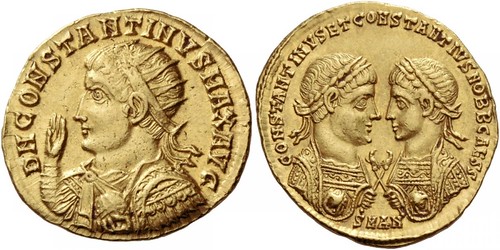
Constantine I, 307 – 337. Medallion of 1 1/2 solidi, Antiochia 326, AV 6.59 g. D N CONSTANTINVS MAX AVG Radiate, draped and cuirassed bust l., raising r. hand and holding globe in l. Rev. CONSTANTINVS ET CONSTANTIVS NOBB CAESS Confronted laureate busts of Constantine II and Constantius II, each wearing consular trabea and holding eagle-tipped sceptre in one hand and globe in the other; in exergue, SMAN. RIC 70. Gnecchi p. 23, 1 and pl. 8, 15. Alföldi 63. Toynbee p. 197. Kent-Hirmer pl. 162, 643. Depeyrot p. 155. Bastien, Donativa, p. 79 note 13.
Of the highest rarity, the finest of only three specimens known of this fascinating issue. Well struck on a broad flan and about extremely fine / extremely fine
Ex Sternberg XXIX, 1995, 528 (illustrated on the front cover page); Triton I, 1997, 1698; NAC 24, 2002, European Nobleman, 279 and NAC 54, 2010, 616 sales.
Taking a page from the Severan numismatic playbook of the early third century, this fabulous gold medallion serves to illustrate Constantine the Great’s concern for the welfare of the late Roman Empire. It advertises his sons, Constantine II and Constantius II, as Caesars (i.e. junior emperors) who would succeed him when he died and carry on the established administration. In short, the medallion presents an image of dynastic stability and implies a smooth transition of power from one ruler to his sons, thereby sparing the exhausted Roman people of yet another destructive civil war. This was important to emphasize since the Tetrarchic system, introduced by Diocletian and Maximianus to solve the same problem in A.D. 286 was ultimately a failure that plunged the Roman world into a series of civil wars between A.D. 309 and 324. The types here attempt to convince us that the tried and true method of smooth dynastic succession from father to sons would save the day in the end.
The medallion was struck, perhaps not coincidentally, almost 125 years after the dynastic series of Septimius Severus. Constantine the Great’s radiate crown seems to be a deliberate throwback to the third century. This medallion was probably distributed as largesse to the army on the occasion of Constantine’s vicennalia (twentieth anniversary as emperor) celebrations that began in mid-A.D. 325 and continued until the final celebration at Rome in July of A.D. 326. In A.D. 326, Constantine the Great shared the consulship with Constantius II for the first time and it is for this reason that the latter is depicted here wearing ornate consular robes and holding the eagle scepter of office. Constantine II had previously served as consul with his father and therefore also appears in his consular attire to complete the symmetry of the reverse type.
To read the complete lot description, see:
Constantine I, 307 – 337. Medallion of 1 1/2 solidi, Antiochia 326, AV 6.59 g.
(https://sixbid.com/browse.html?auction=3509&category=74104&lot=2918292)
London trip (May 9-12)
I arrive in London on Tuesday and was fortunate enough to have a good friend put me up (thank you good friend….you know who you are!). I’ll spend a majority of my time viewing NAC lots and I also will pop by and visit my friends at Roma, Sovereign Rarities and London Coin Galleries. Additionally if time permits there is an interesting small sale of coins at Morton & Eden and I will try to get in there to view those pieces.
To visit Shanna's web site:
http://www.shannaschmidt.com/

ERIC P. NEWMAN INTERNET 3 SALE RESULTS
Last week’s Selections from the Eric P. Newman Collection Internet Part 3 currency auction drew strong competition, with over a third of the more than 1,000 participants having successful bids. This unrestricted Heritage Auctions sale realized nearly $500,000, and 100% of the lots were sold. Several four-figure items joined new cabinets. Lesser value, but specialized varieties and unusual notes recognized for their significance, brought surprising results. Eric’s lifelong study of the nuances of numismatic items, regardless of their commercial value, was once again demonstrated.
A great diversity of genres, series, types, and price ranges were featured. The sale commenced with over 300 Colonial currency notes. North Carolina continues to be the most widely collected, and the series has many “sleeper” rarities. The ever-popular North Carolina April 2, 1776, vignetted notes performed strongly, with the low denomination notes in demand, even in lesser condition. Recognizing that Colonial contemporary counterfeits are generally more rare than their genuine counterparts, collectors bid accordingly.
The specialized section of Early American fiscal loan and financial documents was very well received, with both unique and unpublished pieces as well as available types in choice condition often exceeding expectations. A broad range of over 900 Obsolete currency notes were included: Southern Civil War notes tied to military history brought the strongest prices of the genre; Midwestern Obsoletes, particularly early territorial and State of Illinois notes, were also actively pursued; and Choice grade, vignetted notes were also in great demand. The sale results and wide participation are evidence that currency collecting is very active.
Some highlights from the sale are below
Lot 89170: North Carolina April 2, 1776 $1/16 Vase of Flowers
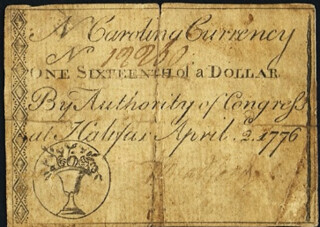
Extremely rare North Carolina April 2, 1776, $1/16 note
Estimate $500-$1,000, price realized $2,115
To read the complete lot description, see:
North Carolina April 2, 1776
$1/16 Vase of Flowers Fr. NC-153f. PCGS Fine 15 Apparent.. ...
(https://currency.ha.com/itm/colonial-notes/north-carolina/north-carolina-april-2-1776-1-16-vase-of-flowers-fr-nc-153f-pcgs-fine-15-apparent/a/241626-89170.s)
Lot 89390: 1780 New-York Treasury Loan Certificate
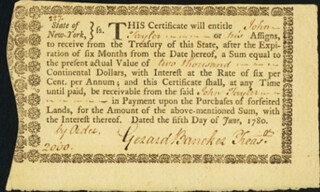
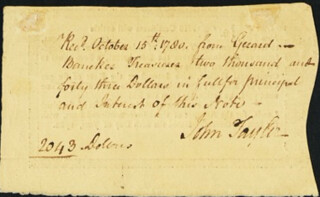
Unreported New York six months June 5, 1780 small format loan certificate
Estimate $1,000-$2,000, price realized $4,700
To read the complete lot description, see:
State of
New-York - Treasury of this State 6% Six Month Loan Certificate "...upon the Purchases of forfeited Lands" 2000 Conti...
(https://currency.ha.com/itm/colonial-notes/new-york/state-of-new-york-treasury-of-this-state-6-six-month-loan-certificate-upon-the-purchases-of-forfeited-lands-2000-conti/a/241626-89390.s)
Lot 89754: 1820 Exchange Bank of Illinois 37-1/2 Cents
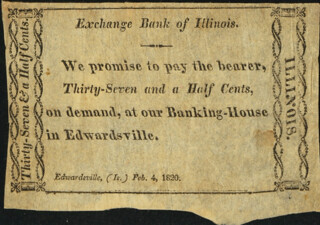
Unlisted Edwardsville Exchange Bank of Illinois
Estimate $400-$800, price realized $4,230
To read the complete lot description, see:
Edwardsville,
IL - Exchange Bank of Illinois 37-1/2 Cents "on demand, at our Banking-House" Feb. 4, 1820 Haxby-UNL. PCGS Very ...
(https://currency.ha.com/itm/obsoletes-by-state/illinois/edwardsville-il-exchange-bank-of-illinois-37-1-2-cents-on-demand-at-our-banking-house-feb-4-1820-haxby-unl-pcgs-very/a/241626-89754.s)
Lot 90067: 1863 French Point, MO, T. R. Livingston
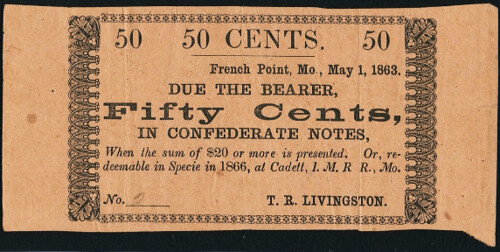
Vibrant Major Livingston French Point-Cadett rail road scrip
Estimate $750-1,500, price realized $4,700
To read the complete lot description, see:
French
Point, MO - T. R. Livingston Redeemable in Specie in 1866, at Cadett, 1 M. R. R., Mo. 50 Cents May 1, 1863. PCGS Very F...
(https://currency.ha.com/itm/obsoletes-by-state/missouri/french-point-mo-t-r-livingston-redeemable-in-specie-in-1866-at-cadett-1-m-r-r-mo-50-cents-may-1-1863-pcgs-very-f/a/241626-90067.s)
Lot 90255: 1816 Great-Bend Bridge 4 Cents
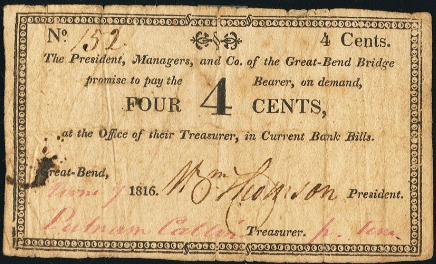
Perhaps unique Great-Bend Bridge 4 cents
Estimate $400-$800, price realized $2,350
To read the complete lot description, see:
Great-Bend,
(PA) - President, Managers, and Co. of the Great-Bend Bridge 4 Cents June 7, 1816 Hoober 141-4. PCGS Very Fine 25 ...
(https://currency.ha.com/itm/obsoletes-by-state/pennsylvania/great-bend-pa-president-managers-and-co-of-the-great-bend-bridge-4-cents-june-7-1816-hoober-141-4-pcgs-very-fine-25/a/241626-90255.s)
For complete, sortable, and printable results of the Newman Internet 3 sale, please visit www.ha.com/241626 .

LEGEND REGENCY AUCTION XXI HIGHLIGHTS
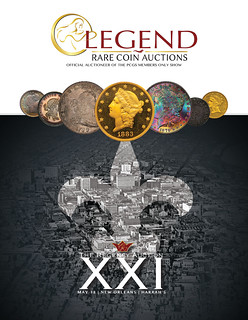 The next Legend Rare Coin Auction Regency Sale will be held on May 18, in conjunction with the PCGS Members Only Show in New Orleans. The Regency Auction XXI will feature one of the most
diverse and impressive presentations of rare coins ever offered in a Legend sale. Three “named” collections anchor the sale: The Bob Simpson Collection of Standard Silver Patterns, Part II; the Linda
Collection of Mint State Trade Dollars; and the Northern Lights Collection of Toned Morgan Dollars, Part IV. Consigned alongside these world class holdings are the coins from many important
numismatists.
The next Legend Rare Coin Auction Regency Sale will be held on May 18, in conjunction with the PCGS Members Only Show in New Orleans. The Regency Auction XXI will feature one of the most
diverse and impressive presentations of rare coins ever offered in a Legend sale. Three “named” collections anchor the sale: The Bob Simpson Collection of Standard Silver Patterns, Part II; the Linda
Collection of Mint State Trade Dollars; and the Northern Lights Collection of Toned Morgan Dollars, Part IV. Consigned alongside these world class holdings are the coins from many important
numismatists.
“There really will be something for everyone in this sale!” declared LRCA president Julie Abrams. “Greg, Laura, and I hand selected 521 lots of quality rare coins. We are really pleased with the way the sale took shape. Early on, we knew we were going to have a great variety of coins to offer, and with the solidification of the market at all levels in auctions, collectors and dealers wanted to take advantage of our boutique style of marketing rare coins to the best buyers out there today.”
An introduction to Standard Silver Pattern Issues
The patterns that fall into a subsection known as the “Standard Silver” patterns make up one of the largest in the entire series. There are three general types: Barber’s Liberty Head, Barber’s Seated Liberty, and Longacre’s Seated Indian Princess designs. In 1869, the first two types were struck in the Dime, Quarter and Half Dollar denominations. In 1870, first two types were struck in Dime, Quarter, and Half Dollar issues, the Seated Liberty design was featured on half dimes, and the Seated Liberty and Indian Princess designs were used on silver dollars also. In 1871 Barber’s Seated Liberty and Indian Princess designs were used to strike all four denominations. The offering of the Bob Simpson Collection focuses on the first type only.
Originally, the Standard Silver coinage series was a proposal to redeem fractional currency notes that were federally issued to try and aid commerce during the Civil War. When hostilities broke out in 1861, gold and silver coinage disappeared from circulation, and by 1863, even the copper nickel cent was hard to come by, putting a strain on day to day business transactions.
As a solution, the government issued banknotes for the first time, including “fractional notes” in denominations under $1 to help with small change transactions. After the war concluded, these notes were still in circulation, and needed to be redeemed. As a way to try and redeem them, officials came up with the idea of issuing coins of the standard .900 fineness, but at reduced weights (rather than keeping the weights the same and reducing the fineness of the silver content). The reduction in weight was proposed at approximately 80% of the weight standard set forth in the Coinage Act of 1853 which reduced the weight of silver coins after the influx of gold from the gold rush which raised the value of silver relative to gold.
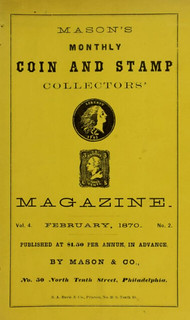 The concept was discussed at length in the Annual Mint Report in for the fiscal year ending June 30, 1870, as well as the February 1870 issue of Mason’s Coin and Stamp Collector’s
Magazine. A lengthy discussion of the proposal appeared in that issue, and really explains 3 goals in issuing these new Standard issues: “First. To reduce the present weight. Second. To make a
close limit on Legal Tender. Third. To limit the amount of issue.” The article continues to discuss the benefits of issuing small change coins versus small denomination notes. (for the complete Mint
Report and article in Mason’s, refer to the excellent reference United States Patterns and Related Issues by Andrew W. Pollock III)
The concept was discussed at length in the Annual Mint Report in for the fiscal year ending June 30, 1870, as well as the February 1870 issue of Mason’s Coin and Stamp Collector’s
Magazine. A lengthy discussion of the proposal appeared in that issue, and really explains 3 goals in issuing these new Standard issues: “First. To reduce the present weight. Second. To make a
close limit on Legal Tender. Third. To limit the amount of issue.” The article continues to discuss the benefits of issuing small change coins versus small denomination notes. (for the complete Mint
Report and article in Mason’s, refer to the excellent reference United States Patterns and Related Issues by Andrew W. Pollock III)
Nothing came from the proposal, and the weights of silver coins would not be adjusted until 1873. However, we have a dynamic numismatic legacy that spans three years, includes three major design types, and was struck in at least three metals, accounting for over 280 variants in the 10th Edition of J. Hewitt Judd’s United States Pattern Coins. These were struck in sets, available to contemporary collectors, and generally included examples in silver, copper, and aluminum, both with reeded and plain edges. Some of the issues are relatively common, rated as R-5 (31-75 examples), while others are UNIQUE, or one of perhaps 2-3 examples.
The coins being offered in the Simpson Collection are of Barber’s bust of Liberty design (Liberty faces right, UNITED STATES OF AMERICA around the upper legend, and IN GOD WE TRUST in a ribbon below), and these can further be broken down into four subtypes:
1. Liberty with a Cap with 3 stars;
2. Liberty with a Cap with 2 Stars;
3. Liberty with a Coronet or Tiara with no Stars;
4. Liberty with a Headband with 1 Star.
To read the complete issue on the Newman Portal, see:
https://nnp.wustl.edu/library/book/511891
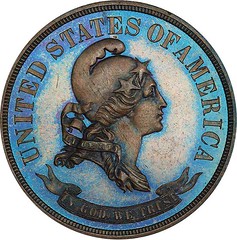
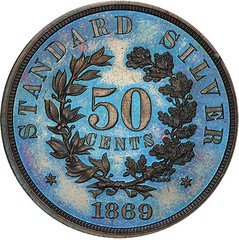
50C 1869 J-745. PCGS PR65+ BN EX SIMPSON
http://legendauctions.hibid.com/lot/31396109/50c-1869-j-745--pcgs-pr65--bn-ex-simpson/
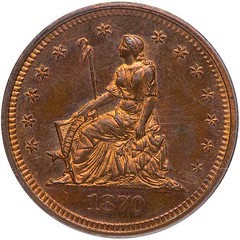
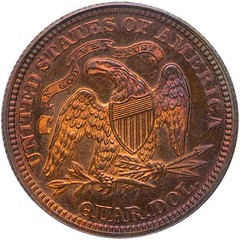
1870 SET OF WILLIAM BARBER SEATED LIBERTY PATTERNS
http://legendauctions.hibid.com/lot/31396176/1870-set-of-william-barber-seated-liberty-patterns/
Highlights include:
- Lot 19. 25C 1869 J-747. PCGS PR66 CAM CAC EX SIMPSON
- Lot 47. 25C 1870 J-894. PCGS PR68+ CAM CAC EX SIMPSON
- Lot 87. $3 1871 J-1167. PCGS PR66 RB CAC
- Lot 90. SHILLING. 1652 PINE TREE. LARGE PLANCHET. PCGS MS64 CAC EX FORD
- Lot 95. 1C 1793 WREATH, LETTERED EDGE. PCGS MS64 BN CAC
- Lot 197. 25C 1822 25/50C. PCGS MS65+
- Lot 304. $1 1798 SMALL EAGLE, 15 STARS. PCGS MS62+ CAC EX MILLER
- Lot 332. T$1 1877-S PCGS MS65+ EX LINDA COLLECTION
- Lot 348. $1 1882-S PCGS MS67+ CAC EX NORTHERN LIGHTS
- Lot 445. 1C-$1 1886 PROOF SET PCGS PR66-67
- Lot 477. $5 1852-C PCGS MS64 CAC EX BAREFORD-BASS
- Lot 490. $10 1908 MOTTO. MATTE PCGS PR67 CAC
- Lot 497. $20 1883 PCGS PR65 DCAM CAC
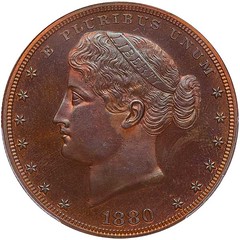
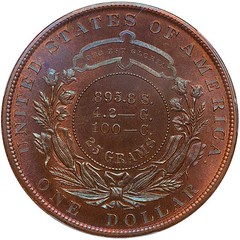
Goloid Metric dollar pattern
http://legendauctions.hibid.com/lot/31396180/-1-1880-j-1649--pcgs-pr66-bn-cac/
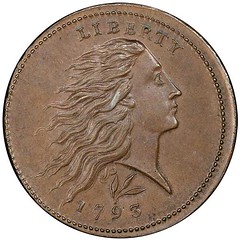
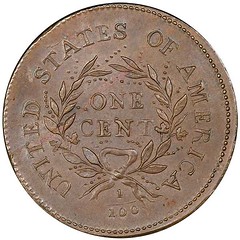
1793 Wreath Cent
http://legendauctions.hibid.com/lot/31396186/1c-1793-wreath--lettered-edge--pcgs-ms64-bn-cac/
From the catalog description:
S-11c. This is the Lettered Edge with a Single Leaf and is tied with one other as the finest known of the type 1793 Wreath Cents.
In 1793 one of the first priorities of the newly opened Philadelphia Mint was to get coins into circulation. While the original bonding requirements for the Mint’s employees delayed precious metal production of silver and gold, there was no restriction on copper, so the first focus of production were these large cents and soon half cents, both struck in 1793. The initial large cent design was the Chain reverse, but that did not meet with public favor, so that design was changed after a few short months to this Wreath design. That too met with disfavor with the public, and for the third time in 1793 entirely new designs were created, the Liberty Cap design, and those finally lasted more than a few months, continuing until mid 1796. Hence type, date and historical collectors all seek out these 1793 cents and there are few available, especially if a high grade Mint State coin is desired. Thankfully one collector will be more than satisfied with this stellar example, with its regal surfaces and finely struck devices.
Listed as #1 in Walter Breen’s Census for the S-11c variety, this coin first appeared in the Dr. Charles Clay Collection, sold by Woodward and Strobridge, December 1877, lot 701; James E. Root; Edward Coggan’s December 1878, lot 231; Lorin G. Parmelee; New York Coin & Stamp Co. June 1890, lot 673; S.H. & H. Chapman; John G. Mills; Chapman Sale, April 1904, lot 1232; Carl Wurtzbach; Virgil Brand; New Netherlands; Harold Bareford Collection, Stack’s September 1978, lot 502; J.M. “Jack” Stone; intermediaries; present consignor.
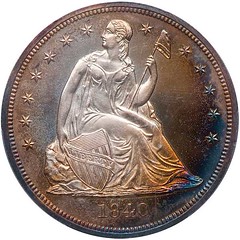
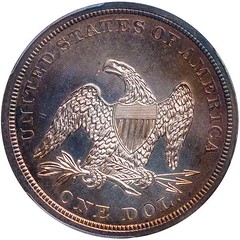
1840 Dollar
http://legendauctions.hibid.com/lot/31396404/-1-1840-pcgs-pr64-cam-cac/
Catalogs are in the mail. If you are not on our mailing list, and you would like to receive a copy, please contact us today.
To visit the Legend Rare Coin Auctions web site, see: www.legendauctions.com
To view the complete sale, see:
http://legendauctions.hibid.com/catalog/100285/the-regency-auction-xxi/
THE BOOK BAZARRE
LORD ST. OSWALD 1794 DOLLAR OFFERED
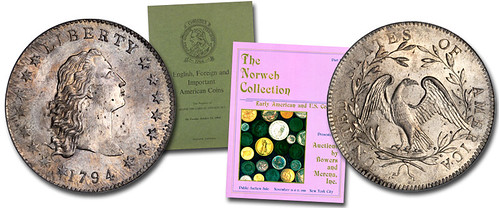
Stack’s Bowers Galleries is delighted to present an important highlight of our August 2017 ANA World’s Fair of Money auction in Denver, Colorado -- the incredible Lord St. Oswald-Norweb 1794 Flowing Hair silver dollar. This MS-64 (PCGS) example was last offered at public auction in the firm’s sale of the Norweb Collection in November 1988.
This incredible specimen has a fascinating but familiar story coming just two years after the sale of its sibling, the MS-66+ (PCGS) Lord St. Oswald-Ostheimer example, in our D. Brent Pogue Collection, Part II sale. In that May 2015 auction, the Pogue counterpart realized an astounding $4,993,750, including the buyer’s premium.
These two 1794 silver dollars remained together for the first 170 years of their existence, until they were offered as part of the Lord St. Oswald cabinet by Christie’s in 1964. The pair had been obtained by English gentleman farmer William Strickland on his tour of the young United States from September 20, 1794 to July 29, 1795. During his visit, Strickland journeyed throughout New England and the Mid-Atlantic, even meeting with Thomas Jefferson at Monticello and with then-President George Washington at Mt. Vernon. The two 1794 silver dollars were among a diverse group of 84 federal and pre-federal coins presumably gathered during his 10 months in America. Centuries later, those two souvenirs would immortalize the legacy of William Strickland and his descendants through the Lord St. Oswald provenance.
The near-Gem Lord St. Oswald-Norweb specimen is among the finest survivors of America’s first silver dollar coinage and is one of the great treasures of U.S. numismatics. The surfaces are impeccably preserved and lustrous, with just gentle traces of planchet adjustment at the obverse border. The coin exhibits strong peripheral definition for the issue, with considerable pronouncement to the left obverse stars and corresponding legend on the reverse. Ranked as fourth finest in the Condition Census and third finest among Mint State examples seen by PCGS, this is a significant world-class rarity.
To read the complete article, see:
Incredible MS-64 (PCGS) Lord St. Oswald-Norweb 1794 Flowing Hair Silver Dollar to be offered in our August 2017 ANA
Auction (www.stacksbowers.com/News/Pages/Blogs.aspx?ArticleID=2523)
STACK'S BOWERS MAY 2017 WORLD ONLINE AUCTION
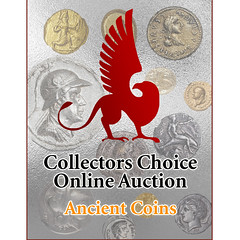
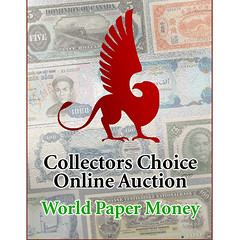
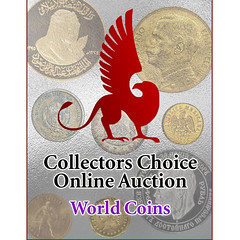
Stack’s Bowers Galleries is excited to announce details of their May 2017 Collector’s Choice Online Auction of World and Ancient coins and World Currency. The Ancient coins auction will begin live bidding on Wednesday, May 17th at 9 AM Pacific Time. World currency will begin at 11 AM Pacific Time. World coins auction will begin live bidding on Thursday, May 18th at 9 AM Pacific Time. The Collectors Choice sales close live, with an auctioneer, though bids may be submitted ahead of time as well.
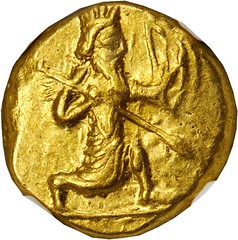
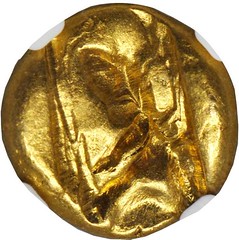
PERSIA. Achaemenidae. Xerxes II to Artaxerxes II, ca. 420-375 B.C. AV Daric (8.33 gms).
The sale begins with over 130 lots of Ancient coins comprising a wide variety of types and designs that are sure to entice collectors. The regions represented include: Celtic, Sicilian, Macedon, Thrace, Athens, Ionia, Syria, Egypt, Rome and Byzantine. One highlight from this section is a lovely Persian AV Daric, created by the massive Persian Empire for trade with the Greeks.
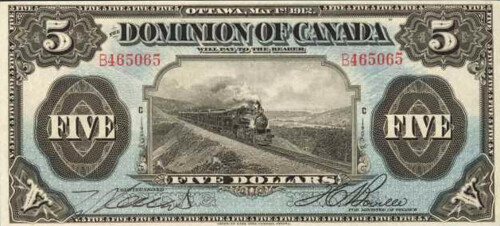
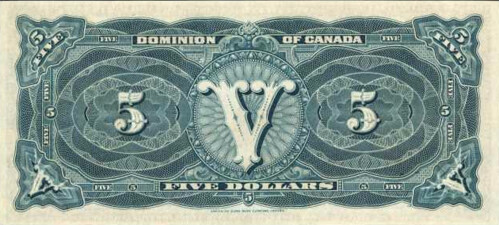
CANADA. Dominion of Canada. 5, 1912B. P-DC-21c. PCGS Gem New 65 PPQ.
The World Currency section contains over 225 lots, with a diverse offering that will appeal to dealers and collectors alike. One special piece is a DC-21c 5 Dollar note from Canada. No seal, series B. These 1912 “Train Notes” are among the most sought after large size Canadian designs. Stunning blue color is noted on both face and back and all the intricate detail is readily available. Original paper quality is confirmed by the "EPQ," designation by PMG and the Gem grade is cemented by the excellent centering and margins.
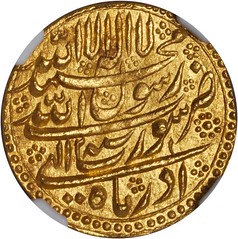
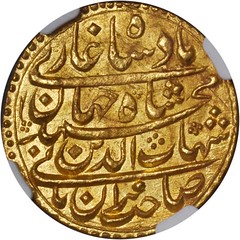
INDIA. Mughal Empire. Mohur, AH 1038 Year 2 (1628/9) ((AH1038)//2). NGC MS-62.
The World Coins portion offers over 1,000 lots. It features prominent sections of France, Germany, Great Britain and all manner of Spanish Colonial coinage, with a large Mexican section. One standout coin is the Shah Jahan Mohur dated AH 1038 Year 2 (ca. 1628/9). The period of Jahan’s reign is considered the golden age of Mughal architecture, and he bequeathed to the world the famed Taj Mahal. Constructed over a two-decade period to honor his late wife, the monument is now considered one of the wonders of the modern world.
Lot viewing will be available at the Stack's Bowers Galleries Santa Ana office before the sale. Check StacksBowers.com for specific dates and times. If you are interested in selling, Stack's Bowers Galleries is your source for auction. The firm offers professional handling of your collection, with a proven track record of accomplished sales. They are currently accepting consignments for their August 2017 ANA auction as well as the August 2017 Hong Kong sale. Contact a consignment specialist at 949-253- 0916 or via email at info@StacksBowers.com
To view the aucton lots online, see:
The May 2017 Collectors Choice Online Auction - Ancient Coins - Lots 70001-70134 (https://auctions.stacksbowers.com/auctions/3-7I22M)
The May 2017 Collectors Choice Online Auction - World Paper Money - Lots 71001-71226
(https://auctions.stacksbowers.com/auctions/3-7I383)
The May 2017 Collectors Choice Online Auction - World Coins - Lots 72001-73026
(https://auctions.stacksbowers.com/auctions/3-7I4PL)
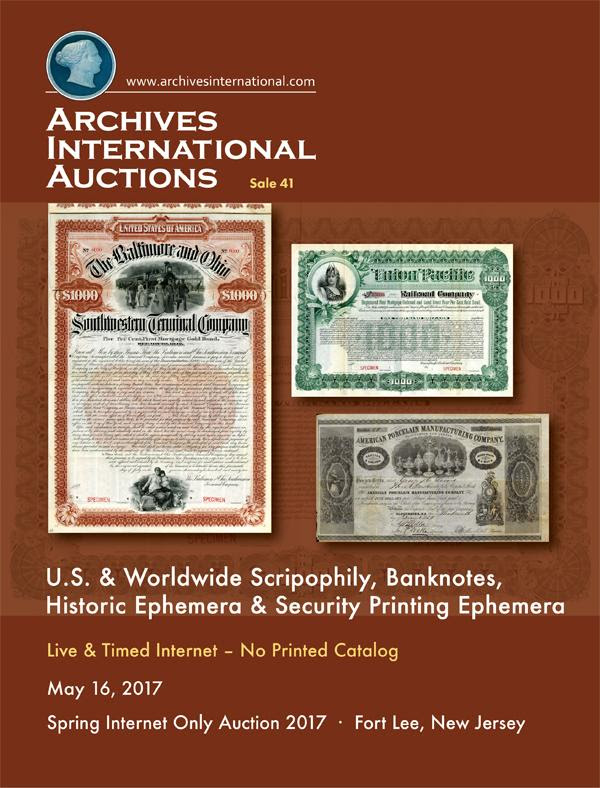
NUMISMATIC NUGGETS: MAY 7, 2017
Syria, Seleucis and Pieria Tetradrachm
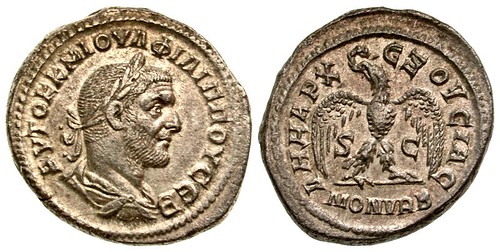
Lot 106. Syria, Seleucis and Pieria. Antiochia ad Orontem. Philip II. A.D. 247-249. AR tetradrachm. Dated A.D. 249.
Syria, Seleucis and Pieria. Antiochia ad Orontem. Philip II. A.D. 247-249. AR tetradrachm (28.46 mm, 13.35 g, 1 h). Dated A.D. 249. AVTOK K M IOVΛ ΦIΛIΠΠOV CEB, laureate, draped, and cuirassed bust right / ΔHMAPX ЄΞOVCIAC, MON VRB, S-C, eagle standing, head left, holding wreath in beak, with wings spread. Prieur 304; McAlee 899
To read the complete lot description, see:
Lot 106. Syria, Seleucis and Pieria. Antiochia ad Orontem. Philip II. A.D. 247-249. AR tetradrachm. Dated A.D. 249
(www.agoraauctions.com/listing/viewdetail/35841)
1627 Book: Discours sur les médalles antiques
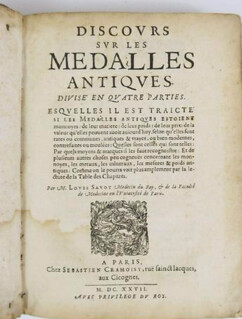 Numismatique - SAVOT (Louis). Discours sur les médalles(sic) antiques. Divisé en quatre parties… Paris, Cramoisy, 1627. In-4 vélin ivoire ép. Mouillure claires sur les premiers ff., qqs
piqûres par endroits sinon bon ex.
Numismatique - SAVOT (Louis). Discours sur les médalles(sic) antiques. Divisé en quatre parties… Paris, Cramoisy, 1627. In-4 vélin ivoire ép. Mouillure claires sur les premiers ff., qqs
piqûres par endroits sinon bon ex.
To read the complete lot description, see:
n°614
: Numismatique - SAVOT (Louis). Discours sur les médalles(sic) antiques.
(http://www.interencheres.com/fr/meubles-objets-art/dessins-art-deco-a-10h30-livres-anciens-et-modernes-a-14h/numismatique-savot-louis-discours-sur-les-medallessic-antiques-ie_v89914/8740410/num)
Pistrucci Waterloo Medal Wax Impression
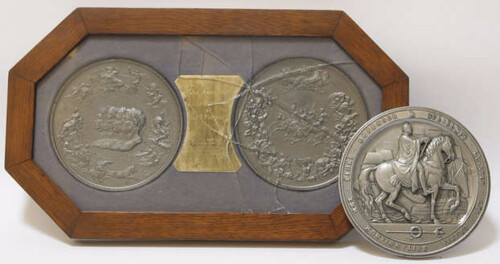
A framed and glazed wax impression of 'The Battle of Waterloo' medal A framed and glazed wax impression of 'The Battle of Waterloo' medal, and one other
To read the complete lot description, see:
A framed and glazed wax impression of 'The Battle of Waterloo' medal
1936 Berlin Olympic Games Participation Medal
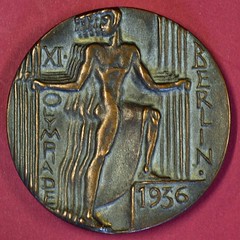
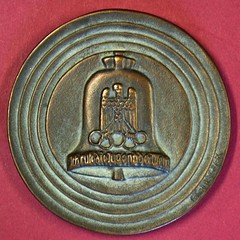
1936 Berlin Olympic Games Participation Medal a cast Bronze Medal by Otto. Placzek, the obverse depicts semi-naked athletes mounting podium, the reverse depicts the famous bell decorated with eagles holding Olympic rings in claw, measures 7cm approx. in good condition
To read the complete lot description, see:
1936 Berlin Olympic Games Participation Medal a cast...
(www.mullocksauctions.co.uk/lot-704540-1936_berlin_olympic_games_participation_medal_cast.html)
This medal was awarded to Athletes and Officials who took part in the Games. Designed by Otto Placzek, showing on one side five athletes representing the different continents, all of whom are engaged in pulling the rope of the Olympic Bell, and the other side showing the Olympic Bell in relief. The medal was cast by four different foundries: Heintze & Bath, Sperlich, Noack and Martin & Pilzing. The medals produced are by each foundry are distinguishable by their colour, but only those by Noack are marked on the edge. The medal was presented in a circular red paper box with a gold coloured Olympic bell on top.
To read the complete article, see: Official Medals and Badges of the Berlin 1936 Olympic Games (https://www.davidfeldman.com/2015/01/official-medals-and-badges-of-the-berlin-1936-olympic-games/)
The Big Dollar Token
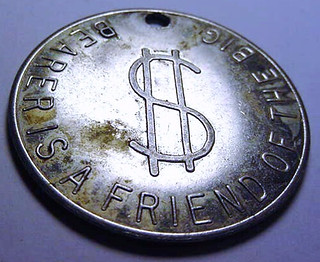
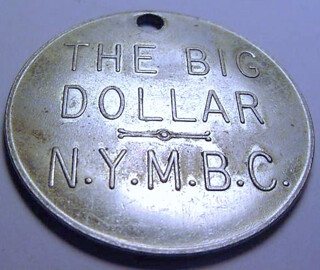
Bearer is a friend of the big $
HE BIG DOLLAR / N.Y.M.B.C.
Anyone have a clue what this means? -Editor
To read the complete lot description, see:
Lot 314: BIG DOLLAR TOKEN (http://www.invaluable.com/auction-lot/-1-c-0CE4D15BDD)
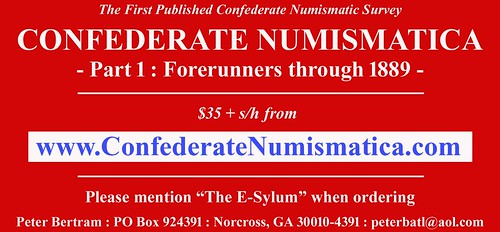
AZERBAIJAN MEDIEVAL BRONZE COIN HOARD FOUND
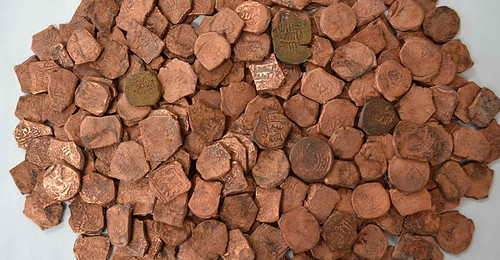
273 copper coins dating to the 12th century have been discovered during excavations near Uzuntepe village of the Jalilabad region, the Institute of Archaeology and Ethnography at the Azerbaijan National Academy of Sciences reported.
The coins were studied by Dr. Ali Rajabli and subsequently cleaned by Dr. Rauf Guliyev.
The coins date back to the rule of Eldiguzids dynasty (12th century), also known as Atabegs of Azerbaijan.
The inscriptions show that the coins were minted on behalf of the Seljuk Sultan Arslan Shah (1161-1176).
The name of the Abbasid Caliph was depicted on one side of the dirham, while the 33rd verse of Surah At-Taubah from the Holy Quran on the other side.
To read the complete article, see:
Hoard of medieval bronze coins discovered in Azerbaijan
(https://archaeologynewsnetwork.blogspot.com/2016/08/hoard-of-medieval-bronze-coins.html#P35J0vujoCjcquxT.97)
MORE ON THE G. ERICHSON COUNTERSTAMP
I enjoyed reading Bill Groom's article on the "G. ERICHSON" counterstamps. Here is some additional information and two pictures from my counterstamp research file.

Gustave Erichson was a Texas gunsmith who worked in the greater Houston area, circa 1838 to 1872 [retirement], and died in 1874. He used several different marks on his guns. I have an image of a gun barrel [from an antique gun auction] that was stamped with the same punches as the coin. The periods/dots in the gun mark were impressed with a separate dot punch. One of the dots is also boldly stamped on the coin [an 1858-O Seated Liberty Half Dollar]. The coin is from the 2010 Stack's sale of the Tony Terranova collection of countermarked silver coins.
During Erichson’s career as a gunsmith [c.1838-1872], Texas was under four flags: the Republic of Texas [c.1838-1845], the State of Texas [1845-1861], the Confederate State of Texas [1861-1870], and finally the State of Texas again [1870-1872].
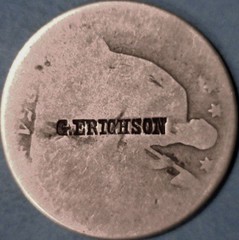
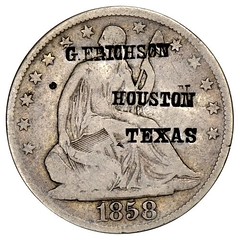
Left: Bill Groom's example; Right: Bob Merchant's
To read the complete article, see:
THE G. ERICHSON COUNTERSTAMP (www.coinbooks.org/v20/esylum_v20n18a26.html)

MORE ON GUY FAWKES AND THE GUNPOWDER PLOT
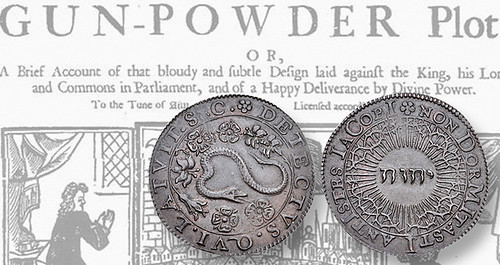
In the piece on "1605 GUNPOWDER PLOT JETON" (v20n17a32), you say: "Thanks to Jeff for highlighting the piece. What other numismatic items commemorate the event?"
First, I would like to make a few points, not mentioned in the E-Sylum piece or at the Coin World page cited:
(a) The jeton has a hidden date (chronogram), in NON DORMITASTI ANTISTES IACOBI – the letters which equate to Roman numerals (DMII I ICI) are larger, and add up to MDCIIIII = 1605.
(b) Amongst the rays is a sort of circle made up of thorns, no doubt intended to refer to Jesus' "crown of thorns" and also perhaps at least some of the other references to thorns in the Bible? (see e.g. https://bible.knowing-jesus.com/topics/Thorns or https://www.kingjamesbibleonline.org/thorns/ - though to me they look a bit like the "double helix" of the DNA molecule!)
(c) These thorns also appear to be an ironic counterpart to the ROSA SINE SPINA motto on some coins, including the Thistle Penny of "James Sixt and First".
(d) Representing France is not a single lys (stylised lily) but four lilies (not stylised enough to be called lys)
(e) As mentioned by Gerard van Loon (Vol.2 page 21/22 of either edition), the lilies (of France) help hide the snake.
(f) As also mentioned by van Loon, the S.C. is for Senatus Consulto – or, more correctly in my view, Senatu Consulto.
(g) The verse referred to is Psalm 121:4 - "Behold, he that keepeth Israel shall neither slumber nor sleep." (KJV) Vulgate: "Ecce non dormitabit neque dormiet qui custodit Israel." (Psalm 120!)
(h) There is probably an allusion to this event and/or the jeton in Shakespeare's "Macbeth", when Macbeth's wife says to him, "Look like th'innocent flower, but be the serpent under't."
(i) It is listed in Hawkins, Medallic Illustrations, 1 p196.19 – and the B.M. have the specimen owned by Hawkins!
(j) It is actually a cinquefoil not rose or rosette at the start/finish of the chronogrammatic legend.
I am not happy about "ratted out the previous day": Lord Monteagle (also a Catholic, and brother-in-law of one of the conspirators) received an anonymous letter warning him not to attend this parliament. On 1st November, this was shown to the king, who (unlike others) immediately realised that the expression "they shall receive a terrible blow this Parliament" referred to an explosion – probably because his own father had been killed in an explosion.
Although Fawkes was seen in the undercroft on 4th, with a large pile of firewood which he said belonged to his master, Thomas Percy, he left at the same time as the searchers. Because Percy was known to be a Catholic agitator, a more thorough search was ordered; this happened around (or shortly after) midnight – Fawkes was again there, and it was seen that the firewood was hiding 36 barrels of gunpowder.
See:
https://en.wikipedia.org/wiki/Guy_Fawkes
https://en.wikipedia.org/wiki/Gunpowder_Plot
https://en.wikipedia.org/wiki/Observance
_of_5th_November_Act_1605
Pinkerton, in his "The Medallic History of England to the Revolution: With Forty Plates" (1790), makes two mistakes (page 30. #7):
(a) He translates NON DORMITASTI ANTISTES IACOBI as “Thou hast not slept, O High Priest James!"
(b) He says, "The numeral letters being picked out, make the year M.D.C.III." - having failed to pick out the I...I in DORMITASTI.
Anyway, here is my offering for a list of "5th November 1605" numismatic items, based in part (#2 thru #6) on a "Fourth Garrideb" item, referenced by The E-Sylum
(v18n46a21), at http://fourthgarrideb.com/2015/11/numismatic
-remembrances-of-guy-fawkes-and-the-gunpowder-plot/
1) that jeton, see http://www.coinworld.com/news/world-coins/2017/
04/bronze-jeton-marks-disruption-of-1605-gunpowder-plot.html
2) British £2 of 2005, with correct edge legend “REMEMBER, REMEMBER THE 5TH OF NOVEMBER”, as described; has anybody noticed that the maces, croziers and swords are somewhat reminiscent of the rays in the above jeton?
3) As above, but with error (or poor quality) edge as in the accompanying photo though not noted in the article – looks more like "PEMEMBER PEMEMBER"; many such coins are being offered for sale on eBay at a considerable premium.
4) (2014) undated copper round (1 ounce, not 20!) by the Presston Mint of New York City as part of their Apocalypze medal series, featuring a Guy Fawkes mask.
5) undated copper round (1 ounce, not 20!) by Copperhead Bullion, featuring Guy Fawkes in front of the Houses of Parliament and Big Ben. The reverse shows several kegs of gunpowder. See also http://guyfawkescoin.com/
6) a "hobo nickel" by Stephen D. Cox
7) Cook Islands 5 dollars 2016, see http://agaunews.com/cultural-icon-guy-fawkes-mask-adorns-new-silver-coin-powercoin/ or
https://firstcoincompany.com/S/cook-islands-1st-anonymous
-3d-guy-fawkes-mask-5-silver-coin-high-relief-
smartminting-technology-special-black-proof-finish
-2016-porcelain-effect-1-oz?filter_name=fawkes
8) Cook Islands 5 dollars 2017, see https://firstcoincompany.com/S/cook-islands-2nd
-anonymous-3d-guy-fawkes-mask-historic-
silver-coin-5-high-relief-smartminting-technology
-special-black-proof-finish-2017-porcelain-effect-1-oz
9) Isle of Man Crown, 2005 (fireworks night over the 1830s Palace of Westminster), see http://www.pobjoy.com/products/view/isle-of-man-2005-remember-remember-the-5th-of-november-gunpowder-treason-an or https://uk.pinterest.com/pin/320670435946974735/
10) Isle of Man Crown, 2005 (Yeoman Warders and the Tower of London), see http://www.pobjoy.com/products/view/isle-of-man-2005-400th-anniversary-of-the-gunpowder-plot-tower-of-london-cu or
https://uk.pinterest.com/pin/342273640410019856/
Note: Both the above are now "dead links", but see http://ancienthackney.blogspot.co.uk/2010/
10/gunpowder-plot-guy-fawkes-night.html
http://2.bp.blogspot.com/_Jl3ytlG8Wxg/TMv0fAydeOI/
AAAAAAAABNQ/l0ru8YkQR_Q/s1600/2418.jpg or http://web.archive.org/web/20071015110021/
http://www.pobjoy.com:80/ukworld/shopimages/sections/
normal2/gunpowder_plot_03.jpg
11) Very similar to the mask on #6 is the "WE ARE ANONYMOUS / WE ARE LEGION" mask on the round/pendant at
https://blastedrat.com/products/anonymous-copper
-rounds-heavy-solid-plated-w-different-tones-blasted-rat
12) A guitar pick made from #4 above, see
https://coinguitarpicks.com/product/anonymous-guy
-fawkes-1-oz-copper-challenge-coin/
13) several defaced banknotes, see
http://shmyah.deviantart.com/art/Guy-Fawkes-Draw-This-Again-484672551
https://ratherrad.wordpress.com/2012/11/05/commemoration-guy-fawkes-night/
http://blog.pacificlegal.org/weekly-litigation-report
-november-5-2016-guy-fawkes-edition/
To read the earlier E-Sylum articles, see:
1605 GUNPOWDER PLOT JETON (www.coinbooks.org/v20/esylum_v20n17a32.html)
NUMISMATIC REMEMBRANCES OF GUY FAWKES (http://www.coinbooks.org/esylum_v18n46a21.html)

AMERICA'S WWI ENTRANCE MEDALS
Centennial of The United States of America’s Entrance Into World War I (A Medallic Tribute)
Finally after years of attempting to keep us out of the war in Europe President Woodrow Wilson on the 6th of April 1917 asked Congress to declare war on Germany. His patience having been exhausted in his dealings with the Imperial German Government and the American people having been stirred up by a series of incidents including the sinking of the Lusitania and the Zimmerman note, the time had come for America’s entrance into the War to end all Wars.
Declaration of War Medal
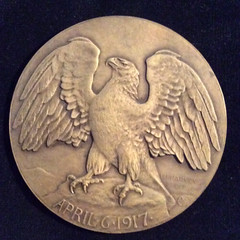 The American Numismatic Society decided to commemorate America’s entrance into the First World War with a medal. Eli Harvey (1860-1957) was commissioned and his Declaration of War
Medal, 1917 was the result. It was bronze, 3-1/2 inches in diameter, produced by the Medallic Art Company, New York. It was to be a single sided piece with a large fierce looking Eagle with its
wings spread, perched on a rock with the date APRIL 6, 1917 below. There were 113 issued in bronze and another 50 issued in silver.
The American Numismatic Society decided to commemorate America’s entrance into the First World War with a medal. Eli Harvey (1860-1957) was commissioned and his Declaration of War
Medal, 1917 was the result. It was bronze, 3-1/2 inches in diameter, produced by the Medallic Art Company, New York. It was to be a single sided piece with a large fierce looking Eagle with its
wings spread, perched on a rock with the date APRIL 6, 1917 below. There were 113 issued in bronze and another 50 issued in silver.
French Premier Alexandre Ribot sent a mission to the United States soon after President Wilson asked Congress to declare war. The French Mission contained both political and military representatives of the Third Republic. Their reason for existence was to coordinate American participation in the Great War. The member of the mission, who stood out the most to the leaders of the Wilson Administration, the Congress and the U.S. Army, as well as the American people, was Marshall Joseph Joffre. For many Americans, Joffre personified both France and her Army as the “Hero of the Marne.” The British, not to be out done by their French counterparts, also sent a similar contingent.
The British and French War Commissions Visit to New York City Medal, 1917
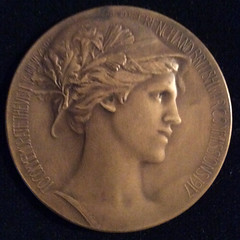
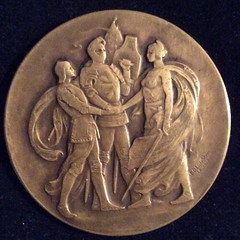
The medal was bronze and had a diameter of 2-1/2 inches. The legend surrounding the rim reads: “TO COMMEMORATE THE VISIT TO NEW YORK OF THE FRENCH AND BRITISH WAR COMMISSIONS 1917.” The reverse design was created by French’s former assistant, and ANS member, Evelyn B. Longman. Her creation is modeled in a more streamlined, hard-edged style, but still features an allegorical configuration of three figures. Joan of Arc represents France; a medieval knight represents England and a flowing draped Lady Liberty, with sword in hand representing the United States coming to the aid of all Europe.
These are just a few of the many World War I medals issued during or following the Great War to Save Civilization. Although the War may have ended a “Renaissance of the American medal,” per Barbara Baxter, it did not stop the energy of the medalists of the world. If nothing else it opened the era of Art Deco and beyond. America would have Victor David Brenner for four more years, James Earle Fraser was here and doing some of his finest work as was his wife and fellow sculptor Larua Gardin Fraser, Julio Kilenyi was in the wings ready to become the next Brenner. Paul Manship was going to produce a few more medals in between his sculpture commissions, John Flanagan was continuing to design medals and coins, Anthony de Francisci was doing fine medallic work as well. America was in very capable hands and on the continent you had the likes of Godefroid Devreese in Belgium, Karl Goetz in Germany, Pierre Turin, Jules Prosper Legastelois, Alexandre Morlon, Marcel Dammann and Maurice Delannoy in France to carry on and influence the future of medallic art.
For more information on the Pennsylvania Association of Numismatists, see:
http://pancoins.org/
CHAMPION PAPER COMPANY MEDALS
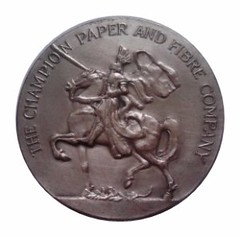 Champion Paper, in small town Canton, has always been the heartbeat of that tight-knit Western North Carolina community. The company saw unparalleled growth from the early 1900’s well into
the latter half of the twentieth century. At the helm was the founder’s son-in-law, Reuben B. Robertson.
Champion Paper, in small town Canton, has always been the heartbeat of that tight-knit Western North Carolina community. The company saw unparalleled growth from the early 1900’s well into
the latter half of the twentieth century. At the helm was the founder’s son-in-law, Reuben B. Robertson.
Robertson had been brought on to temporarily oversee operations in 1907 and ended up staying with the company for an impressive 65 years. Under his watch satellite mills were opened, innovations to manufacturing methods were developed, and overall reach was expanded internationally.
Champion Paper employed a team of chemical engineers and in the 1920’s they pioneered a process to make fine white paper from the pine trees that were so plentiful in the forests of Western North Carolina. Within two decades nearly a third of all U.S. long-fiber pulp would come from native pine. Methods of bleaching spent wood and making high quality paper also originated with this dynamic and innovative little company.
CHAMPION GOES TO WAR
Robertson saw to it that a medal was created for each soldier called into military duty. This medal was presented to the family just before a soldier’s departure. On the obverse was the majestic
Crusading Knight that had been the company’s trademark for so many years. On the reverse was found the soldier’s name below a four-leaf clover, a declaration that he was A DEFENDER OF AMERICAN
LIBERTY and the text CHAMPION WISHES FOR YOU THE BEST OF LUCK AND A SAFE RETURN. Despite the wish of a safe return, there were a dozen men from the Canton division that did not return home.
To read the complete article, see:
The Mid-Century Medals of a Small Town N.C. Paper Mill (www.coinzip.com/articlesPage.php?i=19)
THE BOOK BAZARRE
OHIO TRUMP INAUGURAL MEDAL OFFERED IN SILVER
UPDATE ON THE TRUMP INAUGURAL MEDAL
It is now over two months since Donald Trump's inauguration and still an Official Inaugural Medal has yet to be approved and issued. Almost daily I am asked if there is any possibility that an
official medal will be issued. After consulting a wide array of "experts" and "insiders" I can report without hesitation that I am damned if I know!
One would think that after this amount of time has passed since a medal should have been issued, that there is little likelihood that there will be one. However, this observer is not about to fall into the trap of trying to logically predict what the Trump people will do. I think I can safely say that while the issue is not "dead" it surely is on life support.
Perhaps in reaction to all of this, the Ohio Republican Committee has decided to issue their official Trump inaugural medal in pure silver. An initial striking of 50 medals was made. A small additional striking is expected. As with their bronze medal (of which we have sold over 250) Presidential has been authorized to make these medals available for sale to the pubic. Both bronze and silver medals are available from us as listed below.
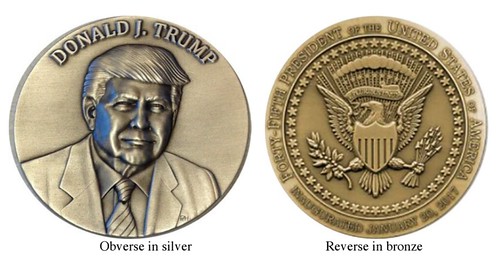
OFFICIAL TRUMP INAUGURAL MEDAL OF THE OHIO REPUBLICAN PARTY 2017. Peer Hansen, Sc. (Medalcraft Mint). Obverse with a high relief front facing bust of President Trump with just a hint of a smile. His name, DONALD J. TRUMP is inscribed above. The reverse legend reads: FORTY-FIFTH PRESIDENT OF THE UNITED STATES OF AMERICA INAUGURATED JANUARY 20, 2017 around a representation of the American eagle as it appears on the Presidential Seal.
A. 70mm. Bronze. Choice Unc. The edge is inscribed MEDALCRAFT MINT at 12:00 and OHIO OIM 2017 at 6:00. Housed in its original presentation box with wooden stand. $60.00
B. 70mm. .999 Silver. (6.25 oz.) Choice Unc. The edge is inscribed MEDALCRAFT MINT .999FS at 12:00 and OHIO OIM 2017 at 6:00. Housed in its original presentation box with wooden stand. (Available about May 15) $375.00
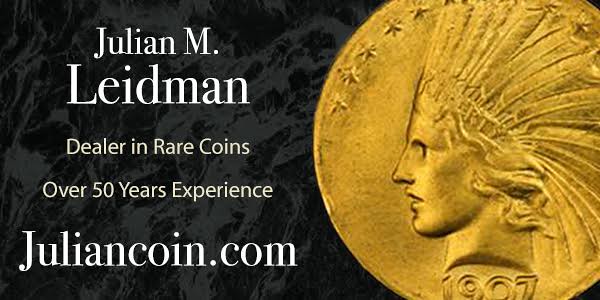
AUSTRIA UNVEILS MIKROKOSMOS SILVER NIOBIUM COIN
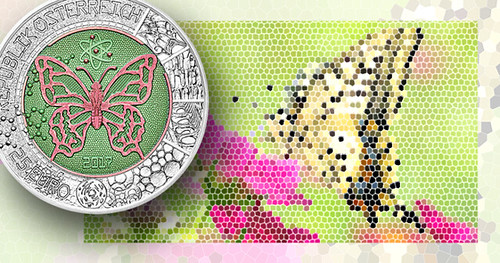
On June 7, 2017, the Austrian Mint will release “Mikrokosmos” (Microcosm), the newest in its extremely popular Silver Niobium series. Inaugurated in 2003, the bimetallic €25 coins have consistently sold out at the mint, and all—especially the first few issues—have gained value on the secondary market.
Each year’s issue is composed of a disc of niobium surrounded by a .900 silver outer ring. The brilliant colors of the disc are achieved by anodic oxidation—a precisely controlled electrochemical process that deposits a fine layer of oxidized niobium on the surface of the disc. The color is determined by the thickness of the layer. From 2003 through 2013, each year’s design was processed with a single color; beginning in 2014, the finely detailed images began to be two-toned, with selectively colored elements set off against a solid background of a complementary color.
Niobium was chosen for the core due to its workability as a coinage metal and its low reactivity (which prevents its corroding where it comes in contact with the silver ring). Niobium’s larger application is in the aerospace industry, making it a thematic fit with the series, whose designs have focused on achievements in science and engineering.
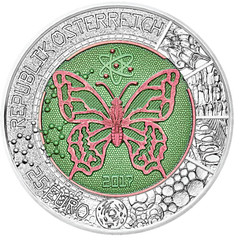
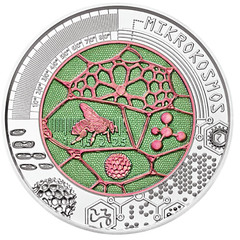
Where the 2014–2016 designs explored such enormous concepts as evolution, the cosmos, and time, the 2017 coin goes in the opposite direction—to the microcosmos. As described by the mint, the means of transport for this journey is a butterfly, which is depicted on the obverse in a raspberry-colored relief design against a grass-green field. The background pattern is suggestive of cells seen under a microscope. An atomic diagram appears above the butterfly; the date, 2017, appears below; and a molecular chain branches off to the butterfly’s left. The silver ring bears the words REPUBLIK OSTERREICH and the denomination, 25 EURO. Other segments of the obverse ring show a close-up of a wing’s tip, a closer view of the “feathers” that cover the wing, and successively closer views of the cellular structures.
The reverse continues the micro-exploration begun on the obverse, but here, the subject is a bee. It appears in front of a ruler that measures its length in centimeters, amid a raspberry-colored web that suggests tissue cells. Another molecular diagram and a large grain of pollen are included, along with what appears to be a cross-section of a honeycomb. The outer ring contains the word MIKROKOSMOS, along with designs indicating the analysis of pollen, bees’ eggs, larvae, and other infinitesimally small bits of the world.
To read the complete article, see:
Austria: Latest coin in popular Silver Niobium series rolls out in June
(http://news.coinupdate.com/austria-latest-coin-in-popular-silver-niobium-series-rolls-out-in-june/)
QUIDS ON THE SKIDS: ERROR POUND COINS APPEAR
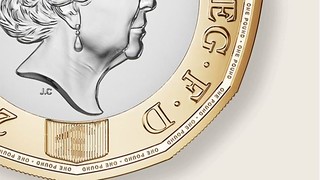 Some new £1 coins - introduced into circulation last month as the "most secure coin in the world" - may be defective, the Royal Mint has admitted.
Some new £1 coins - introduced into circulation last month as the "most secure coin in the world" - may be defective, the Royal Mint has admitted.
It said that a "small number of coins" were affected when they were struck at a rapid rate during production.
The Royal Mint is striking 1.5 billion new 12-sided £1 coins, introduced to help crack down on counterfeiting.
Out of shape versions of the coin, considered collectors' items, are appearing on internet auction sites.
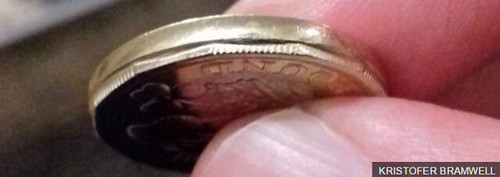
Kristofer Bramwell from Kegworth in Derby tells the BBC:
"I paid for my food with a £20 note and it was in the change. I received it with a pristine minted new 1 pound coin.
"After getting home and eating the takeaway, I took the change out of my coat pocket and I found the badly minted pound coin.
"The edge of the £1 coin is partially 12 sided and rounded where it clearly has not been pressed correctly by the machine."
Philip Munsell, director of Coin News magazine, told the BBC that only a tiny minority of these new coins would be affected, but that fact made them highly collectable.
"The thing about the Royal Mint is that they are very, very good with their quality control, so therefore if you have something that has passed through without being quality checked then it is likely to be collectable, it is likely to therefore be worth more than one pound," he said.
To read the complete article, see:
Royal Mint admits faulty £1 coins are in circulation (www.bbc.com/news/business-39790777)
Some of the coins — supposedly the world’s most secure — appear cracked, warped or have the middle missing.
Officials admitted faults had crept into the minting process.
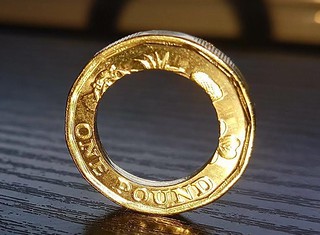 Some of them were left looking like Polos after being issued with their centres missing due to a “comedy of minting errors”.
Some of them were left looking like Polos after being issued with their centres missing due to a “comedy of minting errors”.
Other flawed coins given to Sun readers are misshapen, have sections bleeding into one another or do not have key design details.
The coins are meant to carry a hologram that makes them impossible to forge — but our readers found cases where this security feature was missing.
Coin collector John Taylor, of Crystal Palace, South London, has a £1 with a missing centre and others with “misstrikes”.
Sarah O’Donoghue, from Birmingham, said the silver middle of her £1 coin had bled into the outer gold ring, adding: “It is all melted and out of shape.”
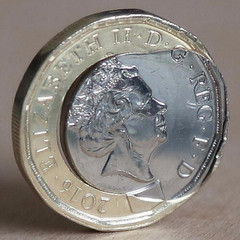
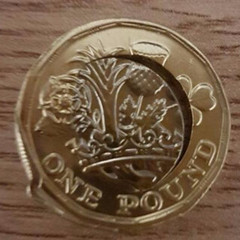
To read the complete article, see:
QUIDS ON THE
SKIDS Thousands of new £1 coins carry major production flaws in embarrassment for Royal Mint – and they have no idea how many more have faults
(www.thesun.co.uk/money/3466439/thousands-of-new-1-coins-carry-major-production-flaws-in-embarrassment-for-royal-mint-and-they-have-no-idea-how-many-more-have-faults/)

NOTES ON EMPEROR NORTON'S PRINTERS
John Lumea is from The Emperor's Bridge Campaign, the San Francisco-based nonprofit that advances the legacy of Emperor Norton, the well-known eccentric who captivated the world with his behavior and proclamations.
John has written a new article about the Emperor's numismatic connection, the printed "bonds" or "imperial promissory notes" he sold to his local "subjects" and passing tourists alike. The article focuses on a topic I'm not aware has ever been covered before - the printers of the scrip and Norton's relationships with them.
Among the article's findings are
- Three newspaper items from September 17 to October 1, 1870 that appear to be among the earliest published references to the Emperor's scrip — including by the Emperor himself.
- Three rarely seen photographs of the second Niantic Hotel and the subsequent Niantic Building — San Francisco, c.1865–1875 — that show mid-field views of 511 Sansome, the building where Cuddy & Hughes, Emperor Norton's first printer, operated when he was "doing business" with them. The oldest of these photos may not have been published elsewhere.
- a personal recollection of the Emperor that his second printer, Charles Murdock, published in 1921;
Here's an excerpt - be sure to read the complete article online. -Editor
Cuddy & Hughes
Why did the Appeal feel the need to editorialize about this?
Perhaps it was just a throwaway line — the latest in an endless parade of such lines trolled out by newspapers and magazines, at the Emperor's expense, to fill out a given edition's final column inches.
But, perhaps it also was offered for a more specific purpose: as a preemptive disclaimer against the appearance of any conflict of interest, given that the printer of the paper and the printer of the bonds were one and the same: the firm of John Cuddy (c.1844–1914) and Edward C. Hughes (c.1848–1912), operating professionally as Cuddy & Hughes.
In fact, Cuddy & Hughes and the Pacific Appeal occupied the same building — at 511 Sansome Street, on the southwest corner of Sansome and Merchant.
In his biography San Francisco Lithographer: African American Artist Grafton Tyler Brown (University of Oklahoma Press, 2014), the historian Robert J. Chandler surveys the San Francisco printing scene between 1865 and 1880 and asks [emphasis added]:
With sharp competition from 125 San Francisco printing and lithographic firms over fifteen years, how did a job printer stand out? In 1870, John Cuddy and Edward C. Hughes, in business only since 1869 after buying out their employer, Thomas B. Deffebach, found a novel way. They became "Printers to His Majesty, Norton I." The prerogative of any government is to issue money, and a fifty-cent imperial bond dated November 11, 1870, is the earliest scrip known. Cuddy & Hughes already printed African American Peter Anderson's Pacific Appeal and billheads, and six weeks later, His Majesty chose it as his official paper. The two ultimately produced five differently designed bonds for the Imperial Government of Norton I, Emperor of the United States and Protector of Mexico. Today one of their fifty-cent notes brings $16,000.
Here's a Cuddy & Hughes imperial note that Emperor Norton signed and sold on 29 August 1874:
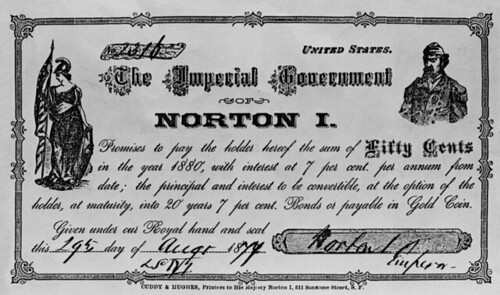
Bond of The Imperial Government of Norton I, made by Cuddy & Hughes and signed by Emperor Norton on 29 August 1874. Source: Jewish Museum of the American West.
The line along the bottom edge — "CUDDY & HUGHES, Printers to His Majesty Norton I, 511 Sansome Street, S.F." — goes right to Chandler's point. Whatever might have been the personal sympathies of John Cuddy or Edward Hughes towards the Emperor, these notes were first and foremost — for them — advertisements for the firm. Within one small sheet, they were able to convey the quality of their paper; their design and typographical sensibilities / capabilities; and the quality of their printing.
C.A. Murdock & Co.
it appears that all the imperial notes signed from January 1878 until the Emperor's death in January 1880 — as well as what Kagin called an "unissued remainder" note from 1880 — were
designed and printed by the firm of C.A. Murdock & Co., headed by Charles A. Murdock (1841-1928).
Emperor Norton liked the Unitarians — and one of the Emperor's favorite ministers was Horatio Stebbins, who succeeded Thomas Starr King at the First Unitarian Church.
Murdock — a staunch Unitarian — was a member of this church; and it seems that this is where he and the Emperor befriended one another.
Murdock's notes are distinguished by the absence of any promotional copy for his own business — which may say any number of things about Murdock, probably all of them good.
Here's a Murdock note signed and sold by Emperor Norton on 20 November 1879.
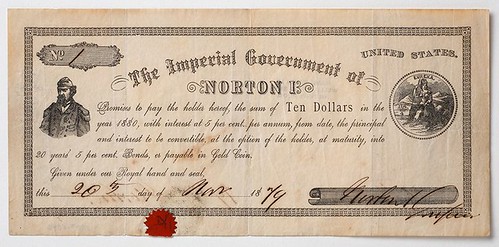
Bond of The Imperial Government of Norton I, made by Charles A. Murdock & Co. and signed by Emperor Norton on 20 November 1879. Collection of the Wells Fargo History Museum / San Francisco. Source: Groove Central LA
Charles Murdock was a keen and sensitive observer of his world. And he lived a deeply engaged and distinguished civic and professional life in San Francisco and Northern California — a life that provided him with a front-row seat to the early development of his adopted city and region, and that brought him in touch with many of its most notable writers and public figures, including Bret Harte, Mark Twain, John Muir and Joaquin Miller.
So it was that, in 1921, at the behest of friends, Murdock published a late-in-life memoir, which he modestly titled A Backward Glance at Eighty.
Here's Murdock's charming recollection of his relationship with the Emperor [emphasis mine]:
No glance at old San Francisco can be considered complete which does not at least recognize Emperor Norton, a picturesque figure of its life. A heavy, elderly man, probably Jewish, who paraded the streets in a dingy uniform with conspicuous epaulets, a plumed hat, and a knobby cane. Whether he was a pretender or imagined that he was an emperor no one knew or seemed to care. He was good-natured, and he was humored. Everybody bought his scrip in fifty cents denomination. I was his favored printer, and he assured me that when he came into his estate he would make me chancellor of the exchequer. He often attended the services of the Unitarian church, and expressed his feeling that there were too many churches and that when the empire was established he should request all to accept the Unitarian church. He once asked me if I could select from among the ladies of our church a suitable empress. I told him I thought I might, but that he must be ready to provide for her handsomely; that no man thought of keeping a bird until he had a cage, and that a queen must have a palace. He was satisfied, and I never was called upon.
To read the complete article, see:
Notes on His Majesty's Printers (www.emperorsbridge.org/blog/2017/5/2/notes-on-his-majestys-printers)
To read earlier E-Sylum articles, see:
ARTICLE PROFILES “THE EMPEROR OF THESE UNITED STATES” (www.coinbooks.org/esylum_v17n40a27.html)
EMPEROR NORTON'S PROCLAMATION AND SEAL (www.coinbooks.org/esylum_v18n18a22.html)
EMPEROR NORTON FILMS NOW ON INTERNET ARCHIVE (www.coinbooks.org/v20/esylum_v20n17a09.html)
INTERVIEW WITH CRANE CURRENCY CEO DEFALCO
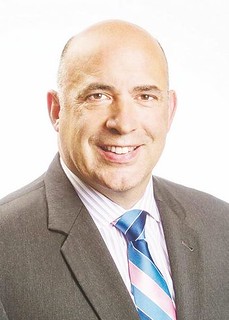 AS A LONGTIME tech entrepreneur, Stephen DeFalco knows what it takes to make money. As CEO of Crane Currency, he leads a company that makes money making money - the banknotes used by
countries all over the world.
AS A LONGTIME tech entrepreneur, Stephen DeFalco knows what it takes to make money. As CEO of Crane Currency, he leads a company that makes money making money - the banknotes used by
countries all over the world.
In an age when credit cards, mobile payment systems and cryptocurrencies might seem to be giving paper a run for the money, cash remains king. Crane Currency, a New England company founded more than 200 years ago, is among a handful of global players serving the 184 countries that issue banknotes.
DeFalco and his corporate team are housed on the 17th floor of One Beacon Street, a 37-story skyscraper in downtown Boston. Workers at a plant in Dalton, Mass., where the company was founded, produce the currency paper used for the company's clients, which include the U.S. Treasury.
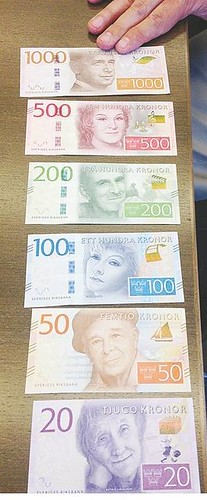 Employees at a plant in Nashua produce the blue polymer material woven into $100 bills - a security feature designed to prevent counterfeiting. It's that 3-D blue line that divides the
bill in half to the right of Ben Franklin's cranky mug.
Employees at a plant in Nashua produce the blue polymer material woven into $100 bills - a security feature designed to prevent counterfeiting. It's that 3-D blue line that divides the
bill in half to the right of Ben Franklin's cranky mug.
"What that blue line actually is is a strip. We send it over to our paper machine, and we weave it into the paper," DeFalco said during an interview in Boston last week. "If you look at it from the back you can actually see that it runs the full course. It's just windowed on the front where sometimes it's under the paper, sometimes it's over the paper."
The Nashua plant, which Crane acquired in 2008 when it bought a local company, employs about 140 people and has openings for about 15 more workers who have skills in chemical engineering, optics, mathematics and statistical analysis, depending on the position.
The plant operates 24 hours a day, five days a week, but over the next year will be converting to a seven-day nonstop schedule, DeFalco said.
Paul Revere's paper
Crane Currency traces its roots to 1775, when Massachusetts papermaker Stephen Crane supplied the paper and mill used by engraver and freedom fighter Paul Revere to make the first U.S. securities so
the young nation could pay its troops during the Revolutionary War. Crane's son, Zenas Crane, established his own paper mill in 1801 and continued what would become a family tradition producing
paper for currency.
For most of its history, Crane was primarily a paper manufacturer, and has been the sole supplier of the cotton and linen blend used by the U.S. government to print currency since 1964. In 2014, Crane sold its technical materials division and the following year spun off its stationery business as a separate company, so it could focus on expanding the currency operation.
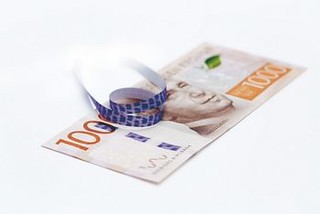 Those moves came after DeFalco joined the company in 2011 as the first outside CEO Crane has ever recruited. The privately held company appointed two other non-family chief executives over
the years, but both of them were promoted from within.
Those moves came after DeFalco joined the company in 2011 as the first outside CEO Crane has ever recruited. The privately held company appointed two other non-family chief executives over
the years, but both of them were promoted from within.
This time, the board wanted a leader with experience leading a technology company rather than someone with a papermaking background. DeFalco, an MIT graduate who had just sold a publicly traded tech company in Toronto, relished the opportunity to return to Boston and run a private company again.
"Our board is a third private equity, a third Crane family and a third independents," said DeFalco, who grew up in New York. "What they really decided is (the company) is going to become a more global, more technology-oriented portfolio."
David adds:
I didn't realize that a New Hampshire facility was involved in one aspect of the $100 bill production.
To read the complete article, see:
Mike Cote's Business Editor's Notebook: Crane Currency is on leading edge of money-making security
(www.unionleader.com/article/20170507/NEWS0206/170509486/-1/mobile)
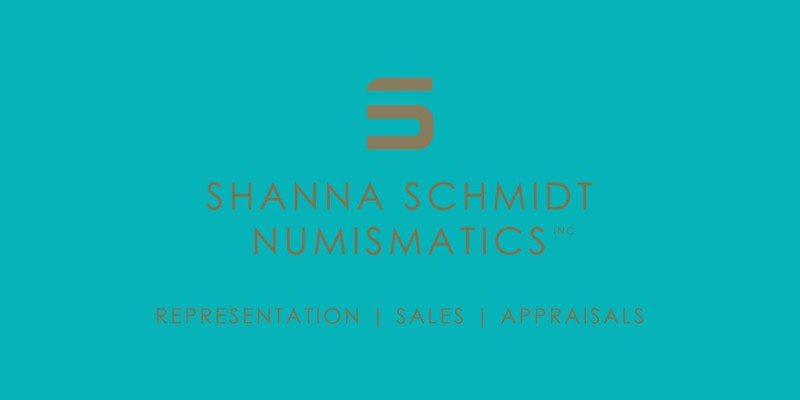
COLLECTOR DISPLAYS BERMUDA BANKNOTES
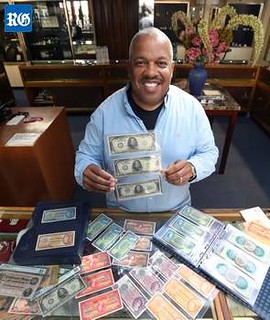 A collection of classic Bermuda notes — including a series of specimens never publicly released — will go on display this month.
A collection of classic Bermuda notes — including a series of specimens never publicly released — will go on display this month.
Peter and Linda Adderley are preparing to display their “Adderley Collection” of Bermudian currency around the island, starting with Fourways Inn, to highlight a small but notable part of local history.
Among the more than 300 notes are everything from the common pound, shilling and dollar notes to rarities.
Mr Adderly said: “It’s a part of our history. If these notes could talk, they would tell a lot of stories. I thought it would be a shame to have such a collection and not let the youth of Bermuda or the wider community see this part of Bermuda’s heritage.
“I love Bermuda notes, and we have some beautiful currency. The new currency has nothing on the old currency. It was really, really nice. You see the City of Hamilton and other places in Bermuda, Bermuda’s heritage, whereas today you have fish and all that.”
“My favourite would be the Bermuda notes,” he said. “It would be the 1941 King George £5 notes. I have binders of currency from other nations, but Bermudian notes are a part of my heritage. It’s where I’m from, money I used to use years and years ago. I know I used to sometimes spend my pennies buying candy. I find Bermuda’s currency very unique. I enjoy collecting Bermuda currency. I get excited, because not too many people have it.”
He said that Bermudian currency is of high demand for collectors, in part due to the island’s small size leading to bills being comparatively rare.
To read the complete article, see:
Banknote collection is a glimpse into past
(www.royalgazette.com/news/article/20170501/banknote-collection-is-glimpse-into-past)
INDIA BANKNOTE BAN VICTIM SEEKS HELP
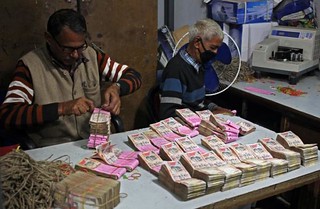 For over a year, Aruna had saved up the money her clients tipped her with at an Indian brothel she was sold in to, thinking could some day exchange the notes once she returned to her
homeland, Bangladesh.
For over a year, Aruna had saved up the money her clients tipped her with at an Indian brothel she was sold in to, thinking could some day exchange the notes once she returned to her
homeland, Bangladesh.
But soon after she was rescued from a brothel in the Indian city of Pune, she learned that the notes she had scraped together – 500 and 1000 rupee banknotes, totalling Rs10,000 – were rendered worthless in the wake of the ban Indian Prime Minister Narendra Modi had put on them in an effort to crack down on corruption.
So with the help of Rescue Foundation, the organisation that freed her, Aruna filed a grievance to PM Modi himself, via Twitter, reports Hindustan Times.
“I used to hide this money from the brothel keeper in my pants pocket as I wanted to take it home,” Aruna wrote in a letter tweeted to Modi late on Tuesday from the Twitter handle of the Mumbai-based Rescue Foundation.
“I earned this money through much suffering. This money is precious. Please help me exchange it,” she wrote. Modi’s shock currency move to withdraw its two highest banknotes aimed to bring billions of dollars of unaccounted wealth that people are hoarding, or “black money”, into the mainstream economy and curb corruption.
But the demonetisation policy has left unintended victims like Aruna with nothing.
Previously employed as a garment worker in Bangladesh, Aruna was trafficked into India by a coworker with the familiar promise of a well-paying job. No sooner than she crossed the border, she was sold as a sex worker.
She worked at a brothel in Bangalore for a year and a half before being sold to another in Pune, where she was rescued a day after arriving, in December 2015.
To read the complete article, see:
Rescued Bangladeshi sex worker’s message to Indian PM via Twitter
over demonetised notes (www.dhakatribune.com/world/south-asia/2017/05/05/rescued-bangladeshi-sex-worker-tweets-pm-modi-demonetised-notes/)
DIGITIZING ONE OF THE WORLD’S LARGEST BOOKS
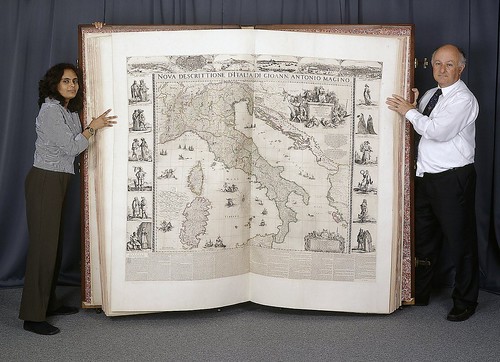
Anne E. Bentley, Curator of Art & Artifacts at the Massachusetts Historical Society writes:
Here's something that will make Newman Portal scanners breathe a sigh of relief that this is an atlas and not a numismatic tome!
The 1660 Klencke Atlas is among the world’s biggest books, measuring nearly six feet by seven and a half feet when open. So when the British Library digitized the towering tome, it required several people to maneuver it to a platform for its high-resolution photographs.
“We digitized the atlas in order to increase access to the 41 maps which are contained in it, which are extremely rare — some known in only three surviving copies — but not terribly well known,” Tom Harper, lead curator of antiquarian maps at the library, told Hyperallergic. “Obviously the atlas is rather a tricky thing to read — though it has wheels fixed onto it to make it easier to move around! Making the maps available free online enables researchers to study these miracles of Dutch cartography and increase our knowledge of the High Renaissance and beginnings of the scientific revolution in the 17th century.”
“The Klencke Atlas is the British Library map collection’s jewel in the crown,” Harper stated. “It was made for Charles II and presented to him in celebration of his restoration to the throne of England — in May 1660, following the English Civil War and Commonwealth. It was presented by the Dutch sugar merchant Johannes Klencke who possibly hoped to win trading concessions in England; there’s a map of the Dutch colony in Brazil in the atlas, where the sugar plantations were based.”
In 2010, the Klencke Atlas went on public view at the London library for the first time in 350 years, and now its digitized pages are available for the public to freely explore, no heavy lifting necessary.
To read the complete article, see:
Watch the British Library Digitize One of the World’s Largest Books
(https://hyperallergic.com/375669/watch-the-british-library-digitize-one-of-the-worlds-largest-books/)
To read the earlier E-Sylum article, see:
THE DEPULVERA BOOK CLEANING MACHINE (www.coinbooks.org/v20/esylum_v20n18a31.html)
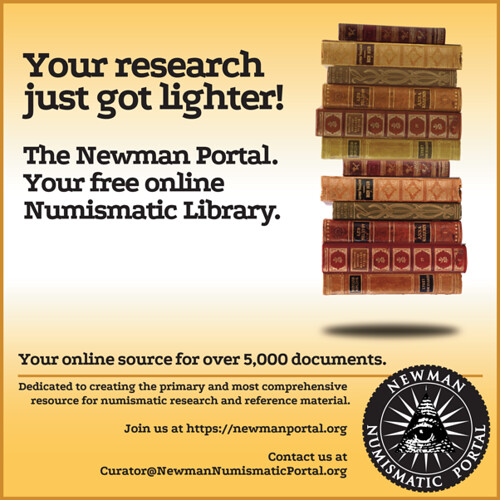
COIN ART BY STACEY LEE WEBBER
Joe Esposito writes:
I saw some interesting jewelry made from U.S. coins by Stacey Lee Webber at the National Archives gift shop. When I looked at her website, I found even more interesting items: power tools, hand tools, trays, baskets, and even a kettle made from coins.
Vessels
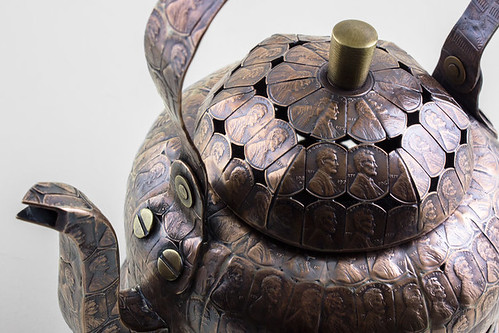
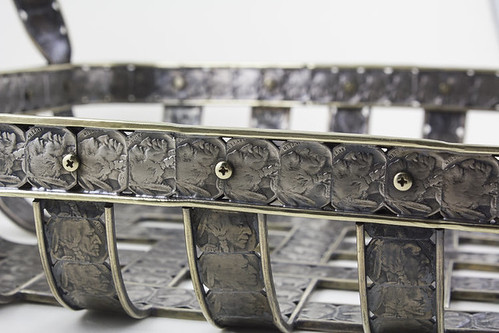
Hand Tools
The Craftsmen Collection contains working man's tools recreated in copper pennies. The sculptures are entirely hollow and true to size. The ghostlike representations of the original tools
question the value of labor and time inherent in the object. Sculptures from this series have been acquired by numerous private collections and the Smithsonian's Renwick Gallery in Washington
DC.
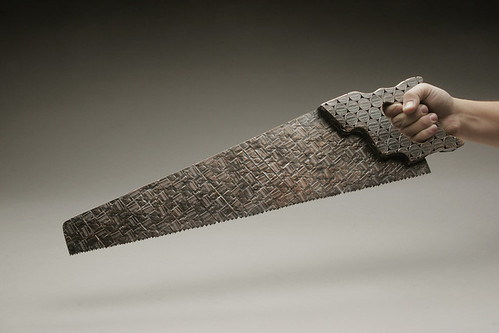
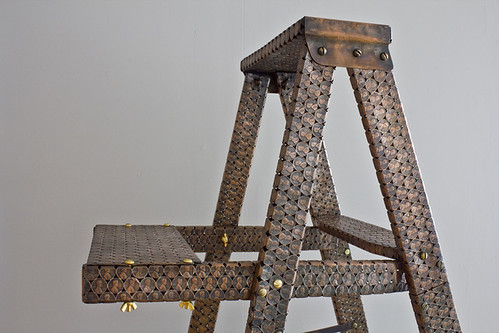
Power Tools
The Craftsmen Collection: Power Tools is a progression of the series into more aggressive electric tools. The power tools are recreated in copper pennies, including the cord and plug. The sculptures
are entirely hollow and true to size. The ghostlike representations of the original tools question the value of labor and time inherent in the object. Sculptures from this series have been collected
by the Fuller Craft Museum in Brockton MA.
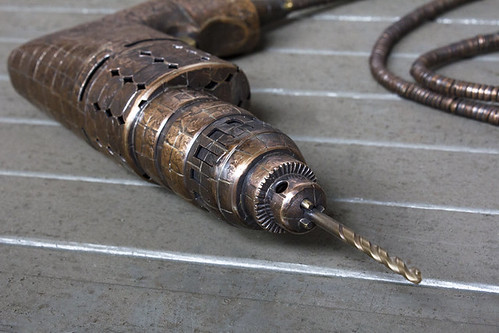
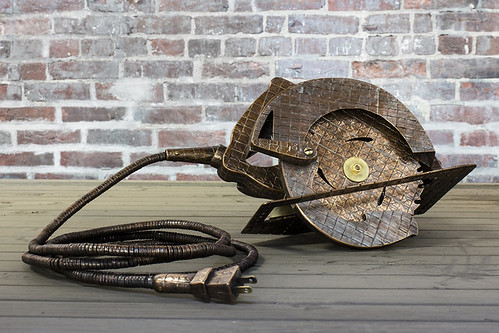
To view more examples, see:
http://www.staceyleewebberstore.com/lockets_c12.htm
http://www.staceyleewebber.com/vessels/
http://www.staceyleewebber.com/power-tools
http://www.staceyleewebber.com/craftsmen/
http://www.staceyleewebber.com/craftsmen-silver-collection/
FEATURED WEB PAGE: THE WATERLOO MEDAL DIES
This week's Featured Web Page pictures the dies for the Pistrucci Waterloo Medal.Medallists were called on to submit their designs for Wellington’s gold medal idea. In 1819, Benedetto Pistrucci, Chief Medallist at the Royal Mint, had his design accepted.
Pistrucci was a controversial figure, an Italian who had worked in France under Napoleon. He had a fiery temperament and an artistic contempt for working with others. He refused to copy the work of respected British sculptor John Flaxman, planning to create and carve his own designs. Pistrucci’s plans featured busts of the Allied monarchs of Britain, Austria, Russia and Prussia, with elaborate classical designs. For this he was to be paid the then-immense sum of £3,500.
Pistrucci had a heavy workload designing coins for the Royal Mint and work on the Waterloo medal was slow. Pistrucci also feared he would be sacked as soon as the medal was finished, so may have deliberately delayed. The carving of the medal dies took an astonishing 30 years.
By 1849, the dies were reportedly finished, but only in terms of design. They now needed to be hardened so that they could be used to strike the medals. This had never been done with such a large and complex design. Although the dies were created in four pieces to assist in their hardening, it seems that nobody was willing to take the risk of damaging Pistrucci’s work that had taken three decades in the making. Eventually, the Royal Mint used electrotyping, a recently invented chemical process, to cast some medals in silver. Unfortunately, by this time all the monarchs depicted on the medal had died, as had almost all the intended recipients, except for the Duke of Wellington.
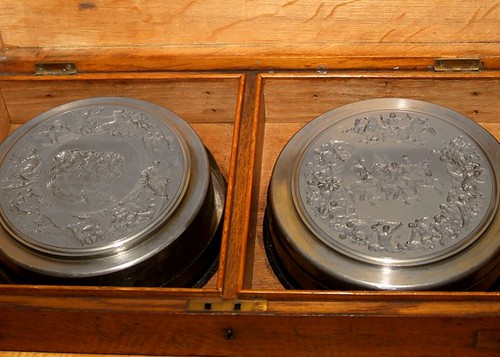
http://waterloo200.org/200-object/
dies-of-the-pistrucci-waterloo-medal/

